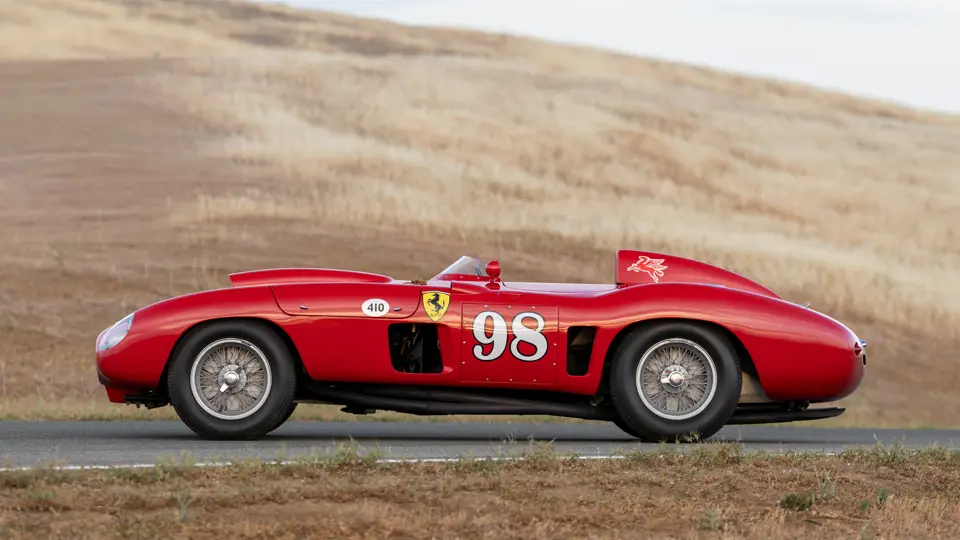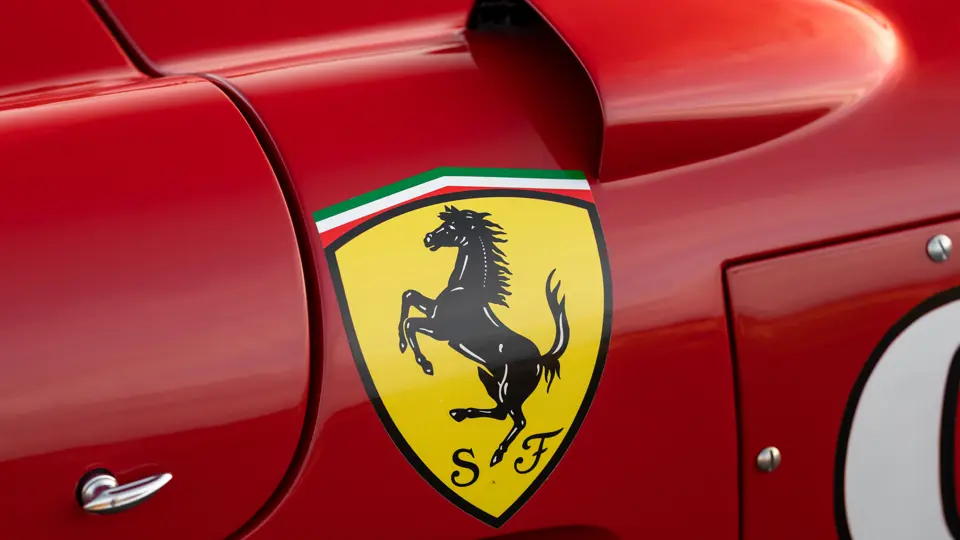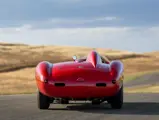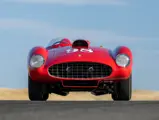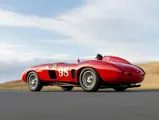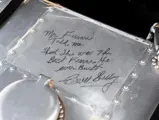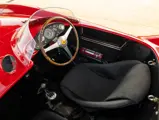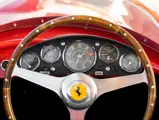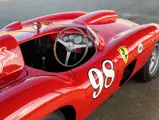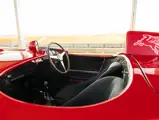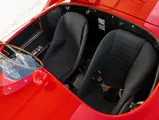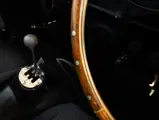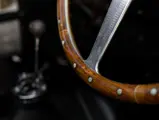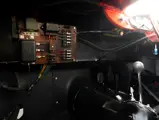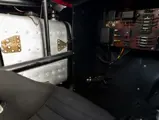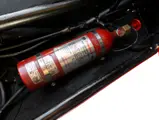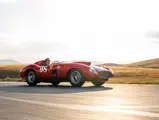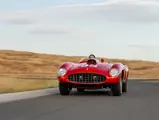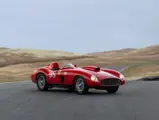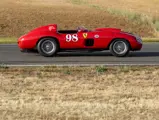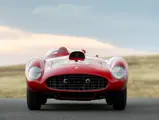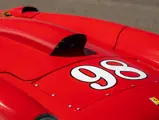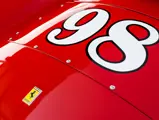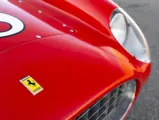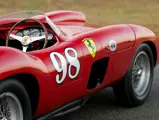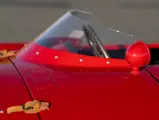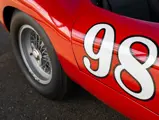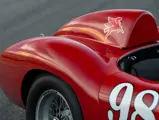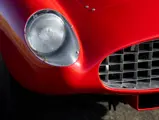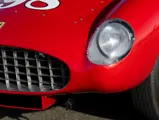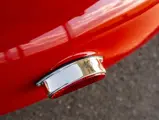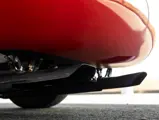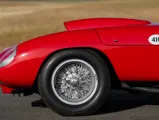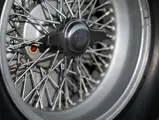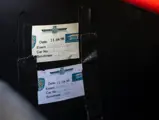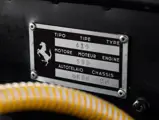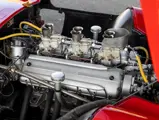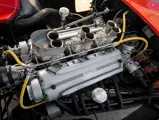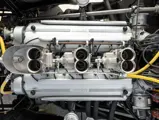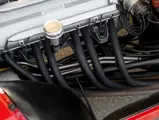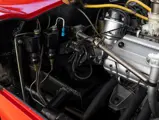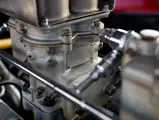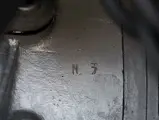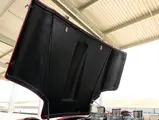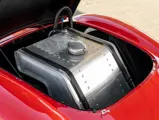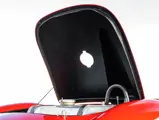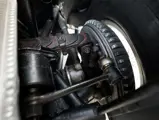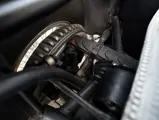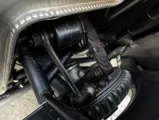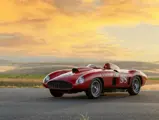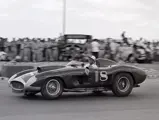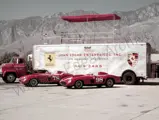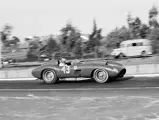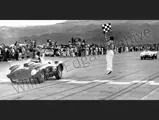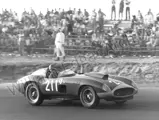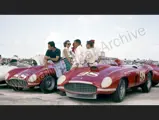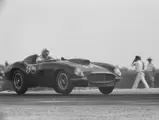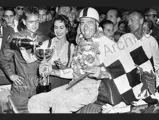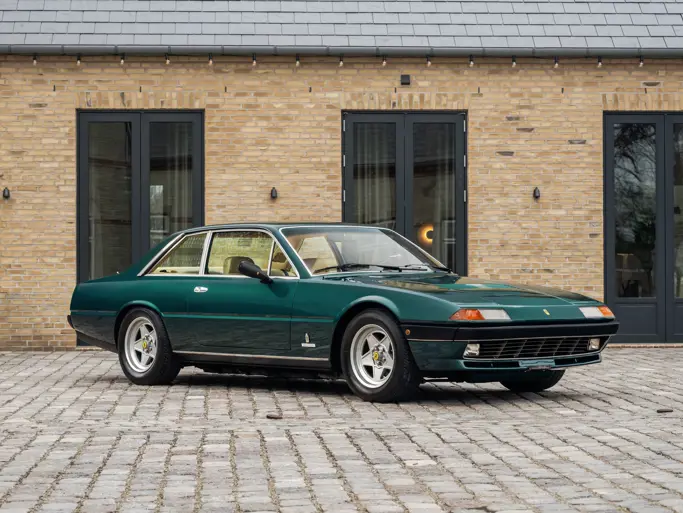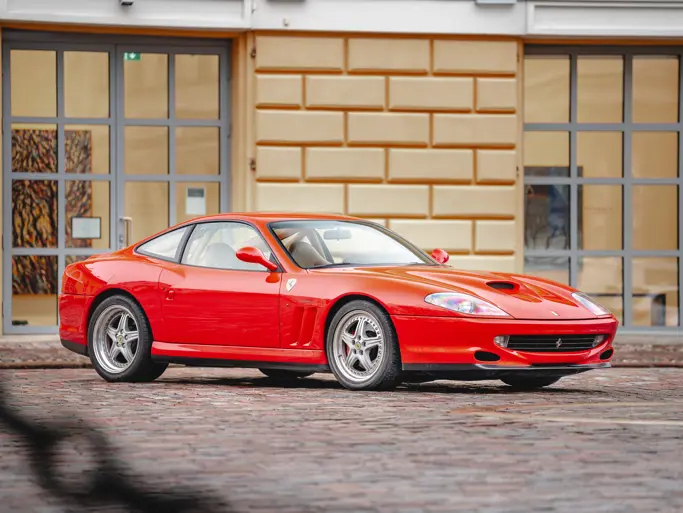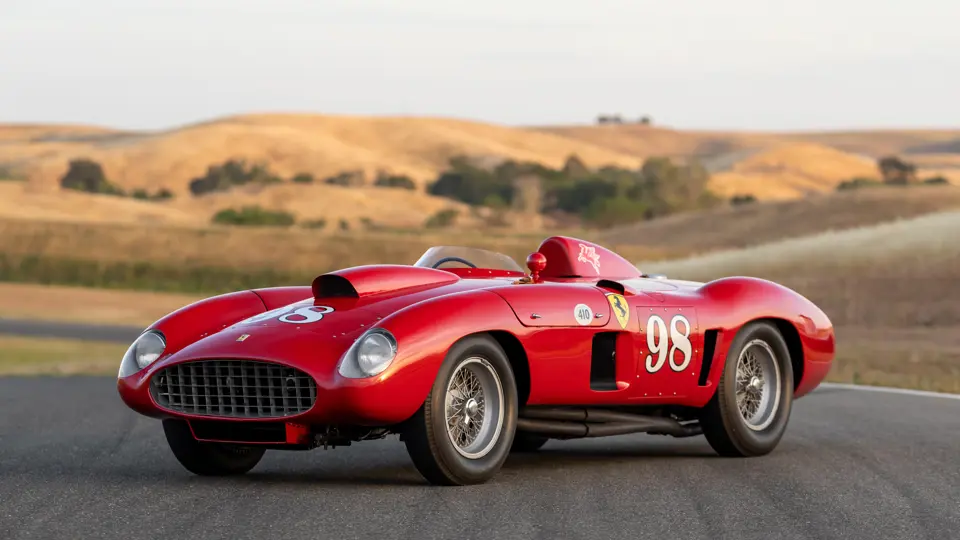
1955 Ferrari 410 Sport Spider by Scaglietti
{{lr.item.text}}
$22,005,000 USD | Sold
{{bidding.lot.reserveStatusFormatted}}
- One of the most significant purpose-built Ferrari “big block” sports-racing prototypes from the 1950s
- One of just two Factory-campaigned 410 Sports equipped with a 24-spark plug 4.9-liter V-12
- Scuderia Ferrari team car driven by Juan Manuel Fangio at the 1956 1000 KM Buenos Aires
- Piloted by Carroll Shelby during his landmark 1956 and 1957 seasons when driving for the renowned Southern California-based team principal John Edgar
- Carroll Shelby won more races as a driver in 0598 CM than any other car in his racing career, with 8 wins and 10 podium finishes
- Also raced in period by legendary drivers Phil Hill, Eugenio Castellotti, Masten Gregory, Richie Ginther, Joakim Bonnier, Bruce Kessler, Jim Rathmann, and Chuck Daigh
- Among the most successful of all even-numbered sports racing Ferraris, entering nearly 40 races in-period with 11 victories and 19 total podium finishes from 1956–1958
- Remains a highly original example retaining the matching-numbers engine, chassis, and body
- One of a select few Ferrari models with coachwork both designed and built by Sergio Scaglietti Fitted with original fuel tank inscribed by Shelby, “Mr. Ferrari told me that this was the best Ferrari he ever built.”
- Accompanied by the first (1956) and last (1958) trophies won by Shelby driving 0598 CM, along with the original 1957 Nassau racing license plate
RISE OF THE KINGFISH
The American sports car racing scene of the 1950s was a time like no other, when fiercely independent, deep-pocketed men could acquire ex-factory racecars and campaign them with some of history’s most legendary drivers. Unfettered by sponsorship concerns or overwhelming regulatory scrutiny, this tightly knit community of men’s men risked life and limb in the events of the Collier brothers’ fledgling SCCA, often competing on old US Air Force tarmacs that had been provided under the auspices of ex-SAC chief General Curtis LeMay. Admirably pure in its essence, this was a golden era of racing that fielded some of the decade’s most beautifully sculpted and ferociously specified competition machines.
Among this niche of sportsmen that included such luminary figures as Briggs Cunningham, Tony Parravano, John von Neumann, and Jim Kimberly, few team owners commanded more respect than John Edgar. Born in Ohio to a wealthy family whose company manufactured kitchen machinery, Edgar was a derring-do character obsessed with speed. As a young man he drove a Mercer Raceabout and a Pierce-Arrow, and he got his start in competitive racing in the field of boating, campaigning four-cylinder outboard racing boats on Midwest rivers and Florida’s inland water by the early 1930s. But this unique character, who quoted Shakespeare and later rubbed elbows with Ernest Hemingway, was not to find a long-term place in boat racing after he sustained a serious accident in Miami’s Biscayne Bay, breaking all his ribs and losing a kidney in the bargain.
After a brief hiatus of soul searching, Edgar resumed competitive activities in a new milieu—sports car racing. He was initially intrigued by a run at the Indianapolis 500, but the corporate atmosphere and cutthroat business did not suit the sensibilities of a man who just wanted to have fun. So, in 1948, having transplanted to California, he showed up at the El Mirage Dry Lake time trials in a souped-up MG TC, where he proceeded to best the 21-year-old Phil Hill.
But Edgar’s future vision crystalized when he attended the Palm Springs race of March 1951 and saw Jim Kimberly’s Ferrari 166 Barchetta, which walloped his further-tuned MG Special by two laps. The racing machine from Maranello was a thing of beauty and power, and he knew that he had to have one.
Shortly afterwards his friend Henry Manney III acquired chassis number 0032 MT, an important early 340 America that Scuderia Ferrari had campaigned at the Mille Miglia and the 24 Hours of Le Mans. Edgar knew the 4.1-liter Lampredi-engined beast would be too much for his friend to handle, and within a month the car was his. With the famed Jack McAfee at the wheel, 0032 MT began racking up SCCA wins in 1953 and 1954 for the nascent Edgar team. Before long, this great success led to Edgar purchasing his next Ferrari, the 1954 Le Mans-winning 375 Plus, chassis number 0396 AM. Bitten by the bug, and increasingly obsessed with winning an SCCA driver’s championship—which he endearingly referred to as “the whole ball of wax”—Edgar went on to purchase a four-cylinder Ferrari 857 Sport, chassis number 0588 M.
The well-tuned and masterfully McAfee-driven 857 S secured a victory at Stockton in 1956, but beforehand, at Palm Springs in February1956, a frustrated Edgar ran into a brick wall of overwhelming power in the form of Tony Parravano’s 4.9-liter Ferrari 410 Sport (0592 CM) piloted by an ex-chicken farmer from Texas named Carroll Shelby. This was the moment of inspiration for Edgar to acquire the most powerful and highly developed sports racer produced by Ferrari yet, the ex-Fangio Scuderia team 410 Sport.
Only in his wildest dreams did Edgar, who was soon to be dubbed “The Kingfish” by the motoring press, surmise that this ex-factory car, chassis number 0598 CM, would soon be piloted for Team Edgar by the charismatic Shelby himself—in the process cementing the Texan’s legacy as one of America’s most talented racing drivers.
BUILDING A CAR FOR A RACE THAT NEVER HAPPENED
Enzo Ferrari was determined to secure the FIA World Sportscar championship in 1955, with the final leg being the Carrera Panamericana: a grueling five-day rally that traversed the Mexican wilderness en route to the border near El Paso, Texas. Ferrari had experienced overwhelming success on nearly every circuit in sports car racing, with the one possible exception being the notoriously dangerous Carrera Panamericana.
In 1952 several privateer Ferraris were entered, including three of Maranello’s latest sports-racers, Vignale-bodied berlinettas built upon the Lampredi 340 racing engine platform. Subsequently known as the 340 Mexicos, these cars showed promise as Luigi Chinetti finished 3rd overall. But a year later the upgraded 340 MM entries could not hold pace with Lancia’s dominating D24 racecars, despite Umberto Maglioli’s commanding 10-minute lead during the race’s final leg. In 1954, Maglioli rumbled to victory in Erwin Goldschmitt’s 375 Plus, but John Edgar’s entry of the Le Mans-winning 375 Plus ended in tragedy as navigator Ford Robinson was killed in a severe accident that miraculously spared the life of Jack McAfee. Riding too high to handle safely, these extremely powerful cars clearly required some chassis development to remain in control on the bumpy and unpredictable surfaces of the Carrera course.
So, for the 1955 Carrera, Ferrari designed an all-new chassis, the type 519/C. It utilized a low-riding tubular spaceframe of unusual width and featured a shorter wheelbase, with the hopes of neutralizing the Panamericana’s uneven roads. Instead of integrating the 375 Plus’s 4,954-cubic centimeter racing engine, however, Lampredi chose to revise his brand-new long-block V-12 designed for the Superamerica road car. At 4,961 cubic centimeters, this was the largest engine yet built by Maranello, and in racing form the type 126/C motor featured Formula One-style twin-plug ignition per cylinder, a quadruple distributor and coil ignition system in 0598 (magnetos in 0596), and three huge twin-choke Weber 46 DCF carburetors to develop nearly 400 horsepower. This was an unprecedented output for a Ferrari sports car—and 40 horsepower more than the initial pair of 410 Sport customer-delivery Speciales (0592 CM and 0594 CM) with Type 126 single-plug engines and Weber 42DCZ/4 carburetors.
Only two 410 Sports were built to these specifications with the intention of factory-based racing. They were appropriately designated chassis numbers 0596 and 0598 with CM suffices, standing for “Carrera Messicana.” After development had begun on the 410 Sport in 1955, however, both the Carrera Panamericana and 1000 KM Nürburgring FIA races were cancelled in the wake of the Le Mans tragedy (in which 83 spectators were killed and another 180 injured when a Mercedes-Benz 300 SLR left the track and disintegrated in the crowd). As a result, Maranello repositioned the 410 Sports to participate in the 1956 World Sportscar Championship racing season, making their debut at the season-commencing 1000 KM of Buenos Aires in January 1956.
The pair of 24-spark cars, chassis numbers 0596 CM and 0598 CM, were respectively driven by the teams of Peter Collins and Luigi Musso, and Juan Manual Fangio and Eugenio Castellotti. Fangio had requested a special modification to 0598 CM that moved the accelerator from its normal position to one between the brake pedal and the clutch. All eyes were on the local hero from Argentina, with the press focusing much of their attention on Fangio and his 410 Sport. After Castellotti experienced a tire issue forcing the car into the pits for repairs, Fangio jumped back in 0598 CM with a significant distance to overcome and furiously chased down Stirling Moss in the leading Maserati 300S. After charging back to the lead lap with Moss in his sights, the differential gave way from the punishment enacted by the feverish pace and raw power of the type 126/C engine on the 89th lap (28 laps after the transaxle had failed on 0596 CM).
Both cars were sent back to the factory for a refit before delivery later in 1956 to privateer clients. John Edgar had waited in the wings for his opportunity at 0598 CM, anxious to obtain the golden chariot that might deliver him a championship.
EDGAR’S MODENA MONSTER
By July 1956, John Edgar had pried Carroll Shelby away from the Scuderia Parravano, where the driver’s efforts were often compromised by the owner’s colorful insistence on tuning the cars himself. While awaiting the delivery of 0598 CM, Shelby garnered a number of wins for Team Edgar at smaller venues, winning the “Race to the Clouds” at Mount Washington, New Hampshire, the Laurel Run Hillclimb, the Brynfan Tyddyn, and the Breakneck hillclimb outside of Cumberland, Maryland.
But the central attraction was scheduled to arrive by airfreight in August 1956 at San Francisco, where the tireless team mechanic and hauler Joe Landaker picked up the 410 Sport and transported it to Bremerton, Washington for the Seafair event. In his inaugural race in 0598 CM Shelby took the checkered flag, setting the stage for many more victories to come. This 1st place Seafair trophy from Shelby’s first race in 0598 CM remains with the car and is included in the sale.
With Shelby’s victories came telegrams sent to John Edgar by none other than Enzo Ferrari, who seemingly took an active interest in Shelby’s continued success behind the wheel of 0598 CM, congratulating him on more than one occasion. Copies of select correspondence are included in the car’s file. At the season-concluding SCCA finale at Palm Springs in early November, Edgar entered six cars, hotly pursuing the elusive championship. The 410 Sport had been dubbed “Edgar’s Modena Monster” by the press, and with Shelby at the wheel, there seemed to be no race it could not win. As Shelby told a Los Angeles Times reporter, “Nothing can touch this Ferrari if it runs.” Decades later he added, “It was the best Ferrari I ever drove.”
Edgar’s son William, who had a front-row view of the entire history, would go on to write about it many times during a significant motorsports journalism career, later summarizing, “The car’s a perfect marriage for Shelby—brash, powerful, brilliant in how it can destroy competition. To see it run is breathtaking. No, scary.”
Shelby won the pole position during Saturday’s preliminary race at Palm Springs, facing a challenging field that included Phil Hill in a Ferrari 857 Sport, fresh from his rookie year with the Ferrari factory team (one that brought the FIA’s 1956 World Sportscar Championship to Maranello). From a 3 PM standing start, Bill Murphy jumped out to the lead in his Buick-powered Kurtis, though he was quickly overtaken by Shelby and Hill. Through the corners, Hill’s nimble 857 S would get the upper hand as Shelby braked hard, then on the straightaways Carroll would pour on the 4.9-liter power to retake the lead. This pattern repeated time and again throughout the race, with Shelby managing to finish first at each lap’s conclusion. In the final lap the two cars battled side-by-side until Shelby roared to victory, just a half-second ahead of Hill.
Shelby later quipped that with his power advantage he could have taken a bigger lead over Hill at any time during the race, but was having too much fun enjoying their epic duel. The captivating Texan had won the race, capping a season in which he won 40 different events, including 18 feature races. Four months later his infectious grinning mug graced the cover of Sports Illustrated magazine, which pronounced him the US Sports Car Driver of the Year for 1956—his celebrity had transcended to a greater stage.
A DREAM REALIZED
In early December 1956, 0598 CM was shipped to Nassau for the Bahamas Speed Week. Confronted with the former RAF airbase’s tarmac of asphalt and crushed coral, Team Edgar knew it needed stronger rubber, and a set of Belgian Englebert tires were ordered to replace the standard Pirellis. Shelby started strong, winning the Friday Governor’s Trophy race, and took Saturday off to rest for the next day’s Nassau Trophy 200-mile main event. Unfortunately, an ill-advised game of touch football played with a coconut left Carroll with a damaged right shoulder, and with more Englebert wear than anticipated he struggled to keep pace with Stirling Moss, Masten Gregory, and the Marquis de Portago, eventually quitting after unscheduled tire stops and in great pain with 70 miles remaining.
As the 1957 season dawned, John Edgar continued to pin his hopes on Shelby in the 410 Sport, and though Carroll failed to qualify at a rain-soaked Pomona race in January, he achieved two wins in February at New Smyrna Beach, Florida. This set up an epic duel at the ritzy Gran Premio de Cuba, a 310-mile race of 90 laps through the streets of Havana and along the beachfront Malecón. Filming the race from the perch of his hotel room balcony, John Edgar watched as Shelby’s 410 Sport held off Portago eventually finishing in 2nd place, 60 seconds behind Juan Manuel Fangio’s Maserati 300S.
From this point forward Edgar began to court Maserati, eventually agreeing to a deal in which Shelby would pilot a 450S, Modena’s prodigious new V-8 powered sports-racer. Maserati later struggled to deliver the car, and instead offered a 300S loaner during the interim. As the contract with Maserati specified that Shelby could not drive a Ferrari under any circumstances, Edgar was content to put Phil Hill in 0598 CM for the Hawaii Speed Week in April 1957. Hill was the fastest driver through the notorious “speed trap” at Dillingham Air Base in Northern Oahu, clocking a staggering speed of 165.12 mph (a copy of this speed certificate is included in the file). After some late-night telephone carousing with Barbara Hutton, however, Edgar agreed to let her son Lance Reventlow drive the Team Edgar Porsche 550, while Hill’s participation in the race with the Edgar Ferrari was inexplicably canceled. A month later Hill finished 3rd at the Santa Barbara race, where the short twisty circuit negated the 410 Sport’s strengths on long straightaways, and shortly thereafter Hill left the Edgar fold for good to race for Scuderia Ferrari at Le Mans.
John Edgar had sunk nearly half a million dollars into the construction of the new Riverside International Raceway, and after Shelby was hurt in a crash of one of the Edgar Maseratis, Richie Ginther was pressed into action in the Ferrari 410 Sport at the venue’s September 1957 debut. From 5th place in the starting grid Ginther looked ahead at some daunting competition, including Chuck Daigh in a Troutman-Barnes Special, Bob Drake in a Ferrari 375 Plus, and Pete Woods in a Jaguar D-Type. Not to be deterred, Ginther took the lead after 22 laps, and he went on to roar to victory behind the wheel of 0598 CM—winning the first feature race ever run at Riverside as a result.
Richie Ginther continued to compete with 0598 CM throughout the rest of the 1957 season, which finished at the Bahamas Speed Week. Ginther achieved several 2nd-place finishes and a total of four different Top 5 results altogether in Nassau. The racing license plate mounted on the car for these Speed Week events is included with the car.
1958 saw less action for the 410 Sport, though it began in exciting fashion at the Gran Premio de Cuba. The Cuban rebels under Fidel Castro notoriously created quite a headache for the Battista government, kidnapping Fangio and very nearly nabbing Moss as well. Masten Gregory drove the Edgar 410 Sport admirably, passing Stirling Moss in a Ferrari 335S and building on his lead. After a Ferrari left the track due to an oil spill and went into a crowd of spectators, the race was red flagged with Gregory in 1st place. Believing he had won the race, he lifted off the throttle. Moss soon flashed past him at full speed and a confused Gregory watched in horror as the checkered flag signaled Moss the winner at the finish line. Moss explained soon after to a furious 2nd place-finishing Gregory that red flag rules required the final lap to be completed before determining race results. Moss realized Gregory would have won the race if not for his confusion over this technicality, and in true gentlemanly fashion, he split his race earnings with Masten 50/50.
Carroll Shelby demanded to take one last drive in his trusted 0598 CM after the Maserati 450S was sidelined due to mechanical issues prior to the Palm Springs main event in April of 1958, breaking the Maserati contract requirements in the process. Back in the hands of Shelby, the 410 Sport responded commendably, finishing 2nd overall. The trophy from Palm Springs, Shelby’s last race in 0598 CM, remains with the car and is included in the sale. Reflecting on his time with Edgar and the 410 Sport, Carroll Shelby would later tell William Edgar, “Racing in the 1950s was really and truly some of the best times of my life, and it’ll never be replaced. It was an era that’s gone and won’t ever be back.”
In October Masten Gregory teamed with the young Swedish sensation Joakim Bonnier to run the Los Angeles Times Grand Prix at Riverside, finishing 11th overall, and 3rd in class. 0598 CM’s swansong victory for Team Edgar occurred two months later in Nassau at the 1958 Bahamas Speed Week, where Bruce Kessler drove the car to a win in Saturday’s all-Ferrari race.
1959 signaled the last year of competition for John Edgar, as financial pressures increased and resulting sponsorship concerns began to cloud the landscape. Edgar made his last-gasp attempts to win the USAC Road Racing Championship with Jim Rathmann behind the wheel of 0598 CM in the first round at Pomona, where overheating issues ended his race, and finally Chuck Daigh’s early retirement with a differential issue during the second round at the 1000 KM of Daytona. Satisfied with his achievements, Edgar soon sold off his stable, including the mighty 410 Sport.
LIFE AFTER RACING
Following its stellar racing career, John Edgar sold 0598 CM to Luigi Chinetti in 1960. The car was pulled out of retirement and prepared for the 1963 Daytona Continental 3 Hours for NART driver “Fireball” Roberts. Racing regulations, however, had changed since the last time 0598 CM took the track. The rules now stated that cars were required to have a fixed roof, which necessitated the fashioning of a crude hardtop so 0598 CM could compete. After practice laps proved the improvised hardtop was slowing the car too significantly to qualify, 0598 CM went back into retirement and Roberts co-drove a Ferrari 250 GTO instead.
Chinetti kept the 410 Sport for two decades, eventually selling the car to Howard Cohen in 1980. Stephen Griswold conducted a restoration for Cohen in 1980-1981 as documented in the Factory-published 1981 Ferrari Album 3, which featured Griswold and marque specialist Nino Epifani’s work on the car. The spider was presented at the 1981 Pebble Beach Concours d’Elegance, where it won the Hans Tanner Memorial Ferrari Trophy.
Sold to Don Walker in 1984 and subsequently competing in the Monterey Historics that same year, the Ferrari was acquired by hotelier Bill Marriott in 1987 and sold a year later to the Swiss collector Engelbert Stieger of the Turning Wheel Collection. He commissioned a cosmetic refurbishment in 1989 by Carrosserie Josef Wagner. After several appearances on the cover of Prancing Horse magazine and a class award at Pebble Beach in 1990, the car was presented by Stieger at the 50th Anniversary of Ferrari meet in Rome and Maranello in May 1997. The car was exercised at vintage driving events, including the Ferrari Owner’s Club Switzerland meeting at Monza in October 1994, the Uwe-Meissner-Pierre Fandel meet at Nürburgring in August 1995, while appearing at the Montreux Grand Prix in 1990 and 2002. The 410 Sport continued to appear at premier venues after acquisition by prominent Ferrari collector Chris Cox in 2005, who drove 0598 CM at the 2005 Goodwood Festival of Speed.
In January of 2006, the Ferrari was acquired from Chris Cox by the consignor, a respected American collector based in Colorado. During his stewardship, the 410 Sport was shown at the 2006 Fabulous Fifties Concours in Gardena, California where Carroll Shelby was reunited with the 410 Sport and autographed the fuel tank, adding the inscription, “Mr. Ferrari told me that this was the best Ferrari he ever built.” After direct prodding from Shelby to the owner, it was later exhibited in 2009 at the Shelby American Collection museum in Boulder, Colorado, and in 2010 the car was shown at the Amelia Island Concours d’Elegance, winning The Spirit of Ferrari Award, presented to the Ferrari that best represents the spirit of il Commendatore. Two years later, in the year of Carroll Shelby’s passing, the spider was displayed at the Pebble Beach Concours d’Elegance, standing as an enduring tribute to the legendary driver.
In late 2012, 0598 CM was returned to Nino Epifani for a complete rebuild of the rare twin-plug V-12 engine that took over three years to complete in 2016, with mutual consultation and assistance from the staff of Patrick Ottis. During this time, it was chosen by Ferrari as one of 60 cars representing the most significant Ferraris in the history of the marque; these were displayed on Rodeo Drive at the 60th anniversary celebration of Ferrari in North America. Recently the car has undergone a full Ferrari Classiche inspection and a detailed report is on file should the next caretaker wish to proceed with obtaining a Red Book.
During its illustrious history, Maranello has built several very significant sports-racers that started life as Scuderia team cars and later became legendary in American privateer circles, but very few of these can compare to 0598 CM. As the car that propelled Carroll Shelby to national attention, and the most successful racer of the respected John Edgar team, this 410 Sport may be regarded as nothing short of a legend. It is indubitably rare, being one of just two factory-campaigned examples that were fitted with the more powerful twin-plug-per-cylinder version of the large-displacement 4.9-liter Lampredi long-block V-12.
Driven by a who’s who of the era’s greatest racing drivers, including Juan Manuel Fangio, Eugenio Castellotti, Carroll Shelby, Phil Hill, Richie Ginther, Masten Gregory, Joakim Bonnier, Bruce Kessler, Jim Rathmann, and Chuck Daigh, 0598 CM is without exaggeration one of the most important and colorful Ferraris to compete in racing during the 1950s. Its current availability offers an unparalleled opportunity to acquire a purpose-built, even chassis-numbered racing sports car of unequaled provenance. Faithfully presented in its period livery and desirably maintained, including the recent engine rebuild by a team of Ferrari specialists, this 410 Sport can expect an enthusiastic welcome at the most exclusive vintage racing and exhibition events worldwide.
Like the famed men who rode it to such success in period, the illustrious John Edgar and the inimitable Carroll Shelby, this Scaglietti-built spider is a powerful and nuanced character that cannot be repeated—and will never be forgotten.
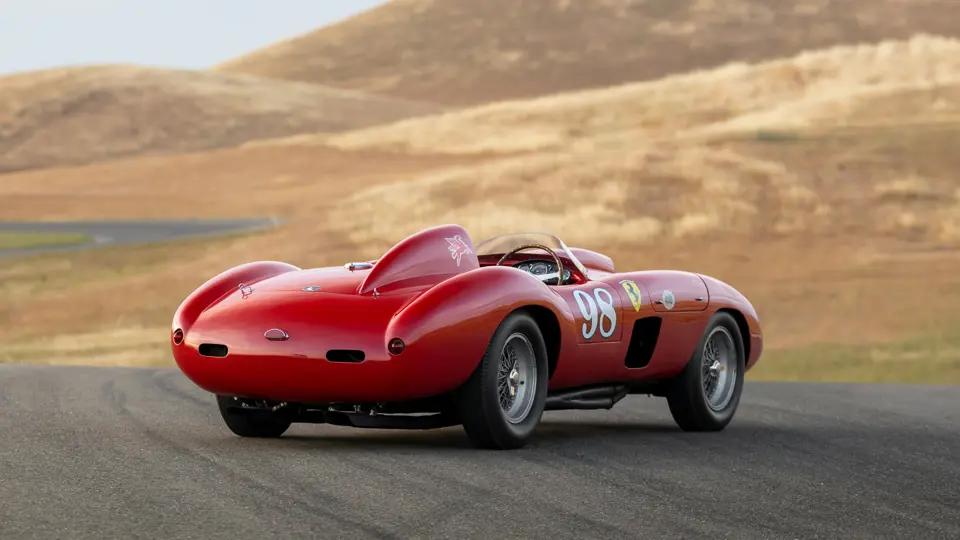

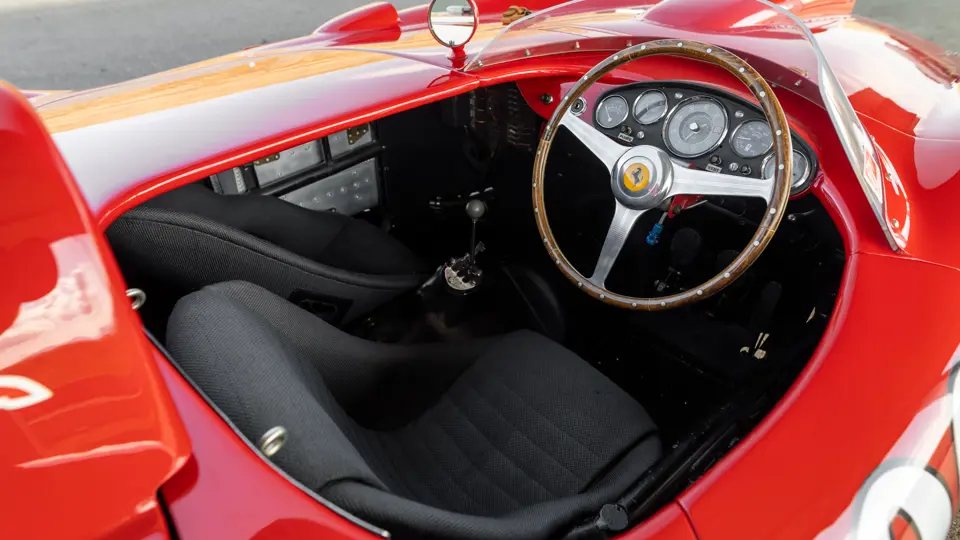

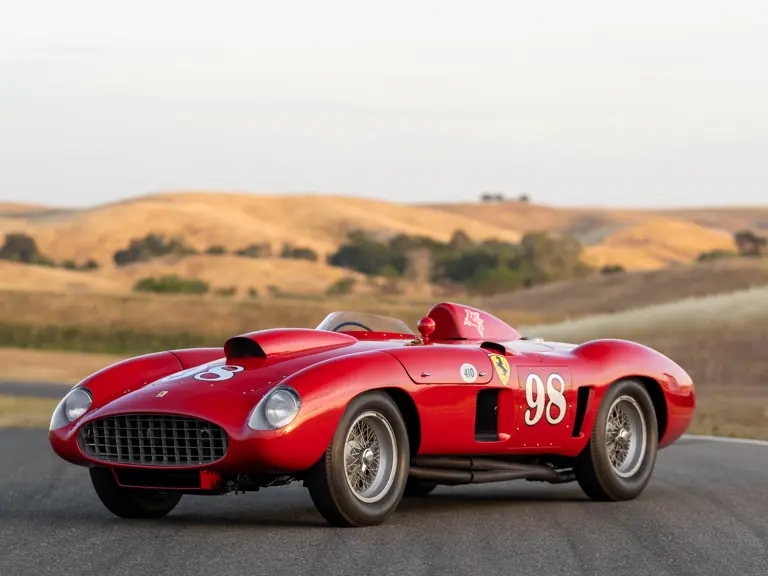
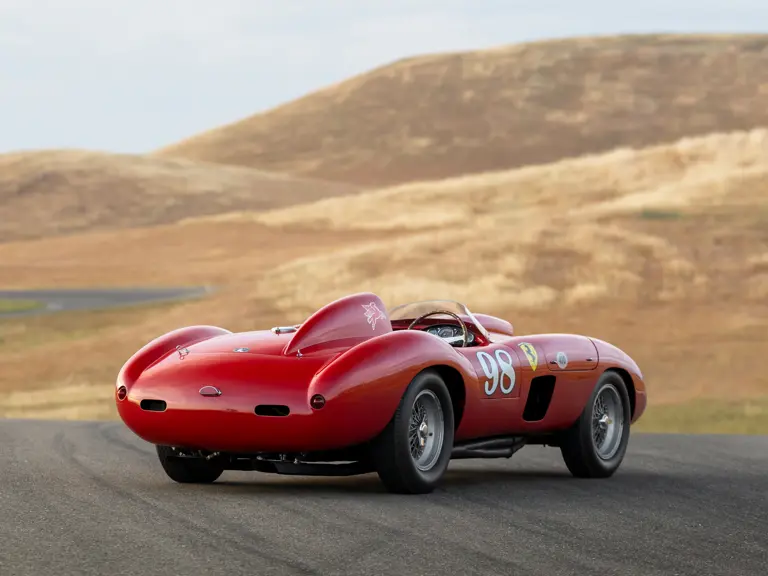
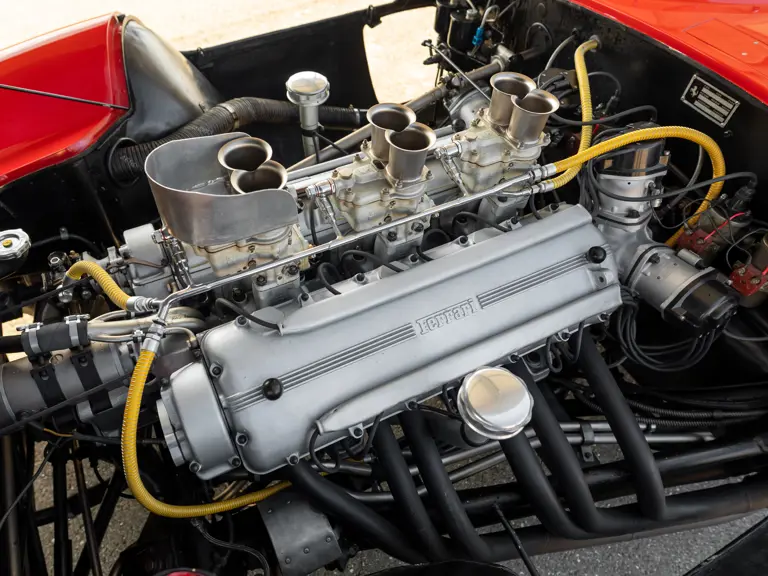
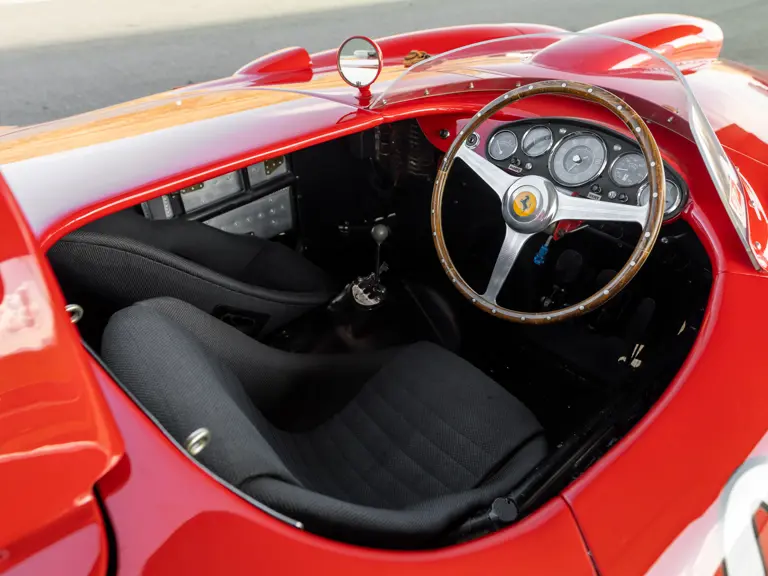
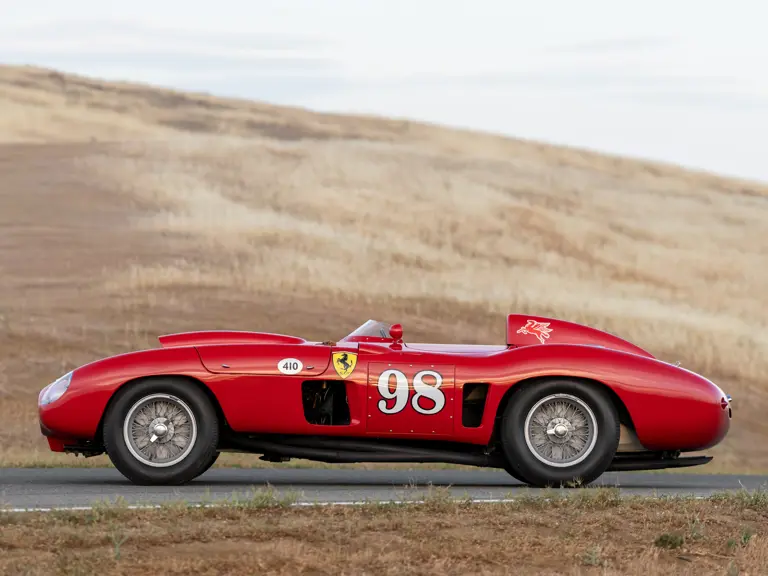
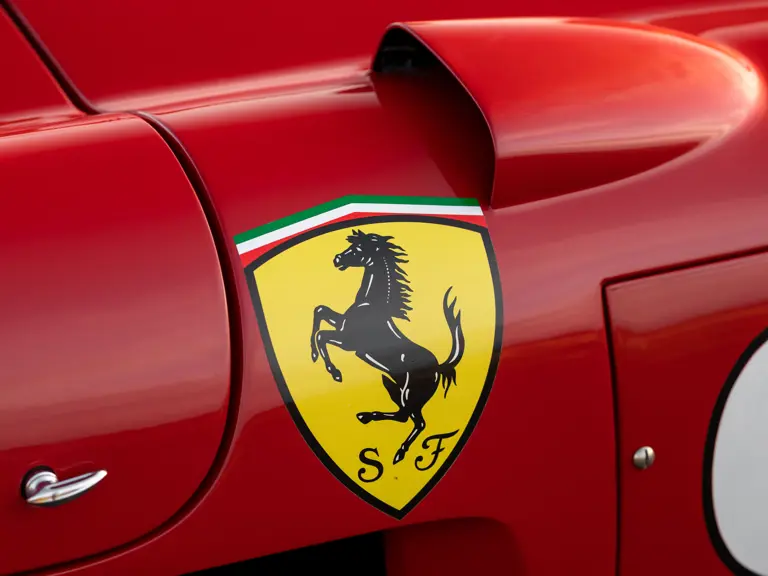
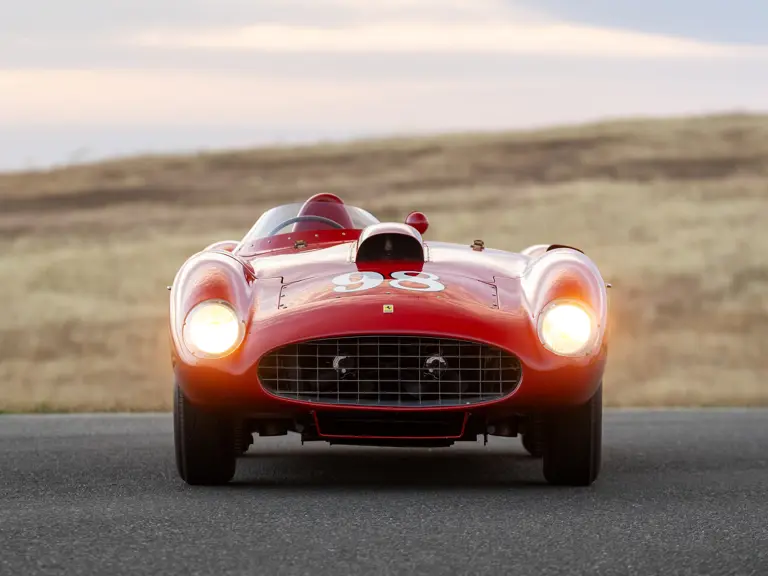
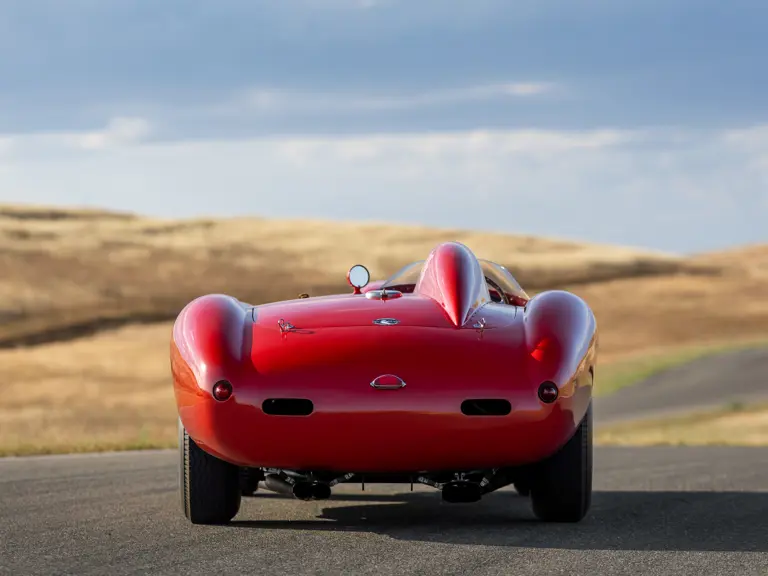
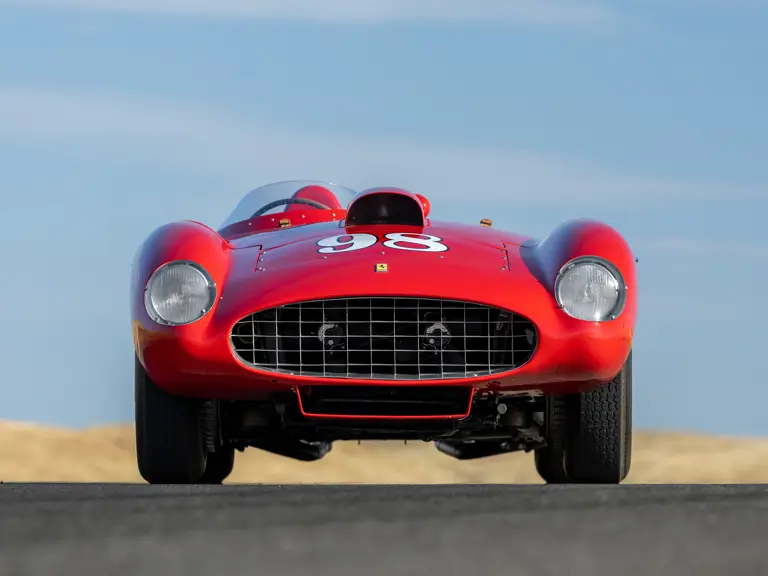
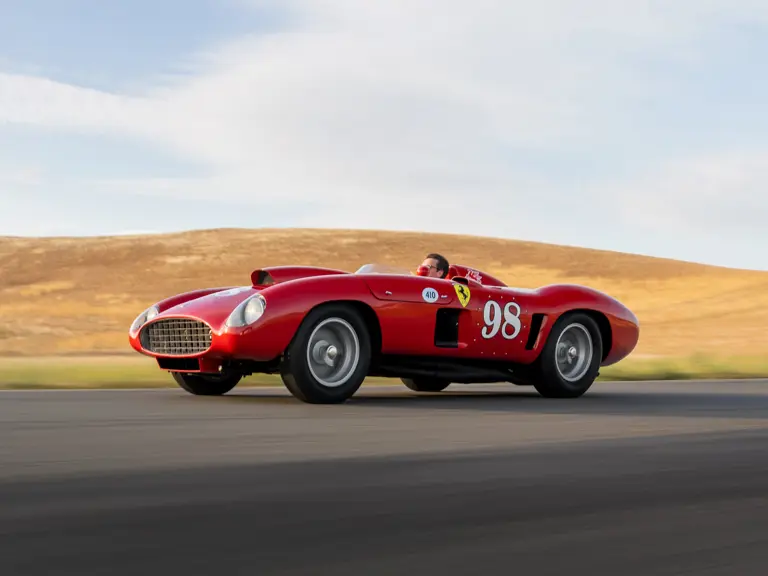

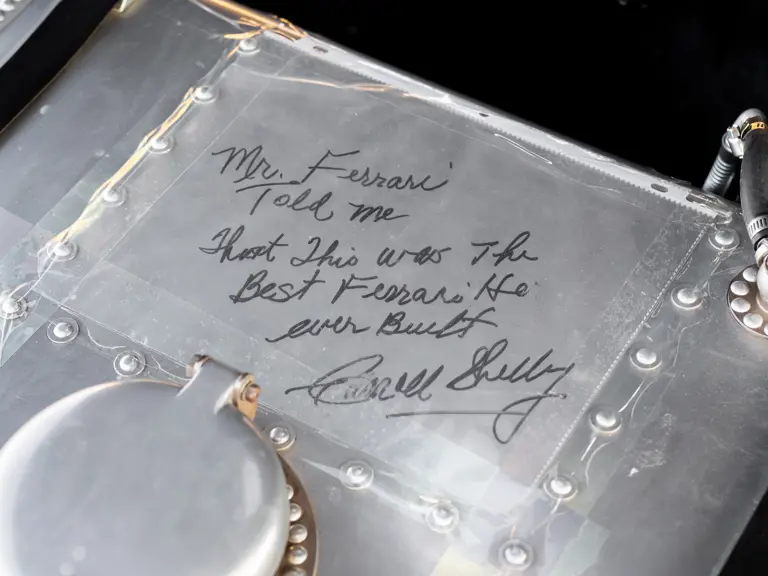
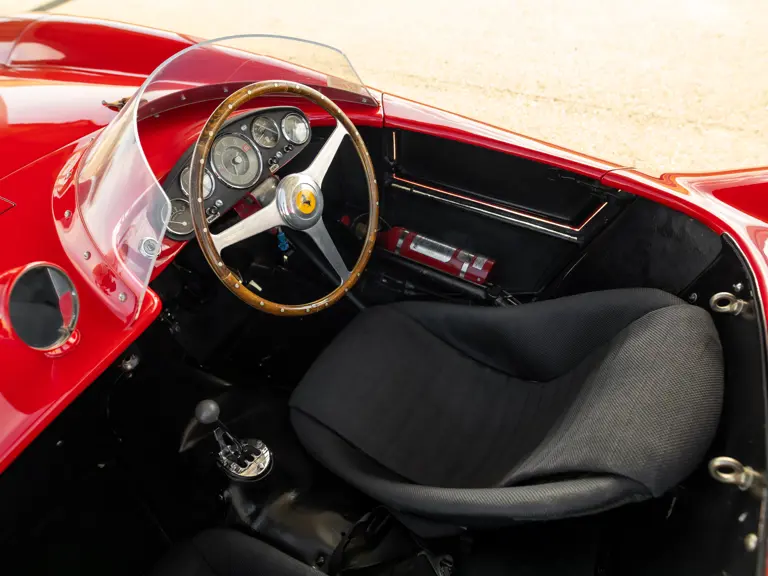
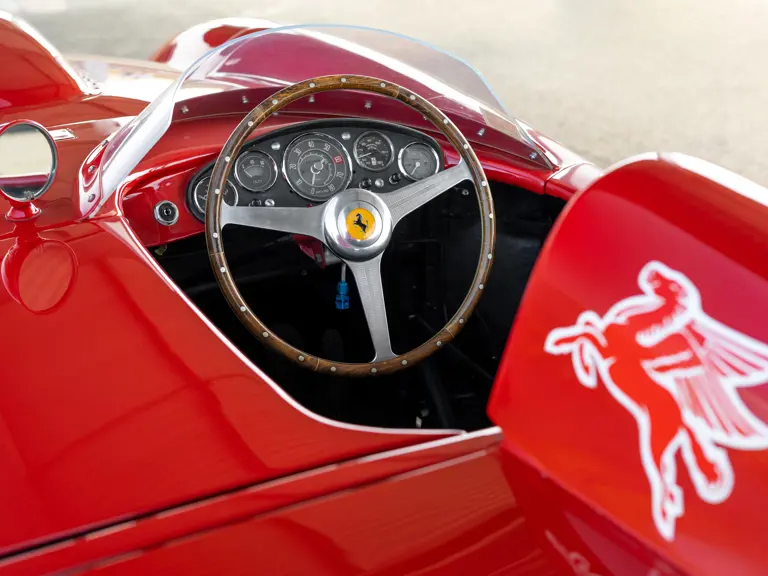
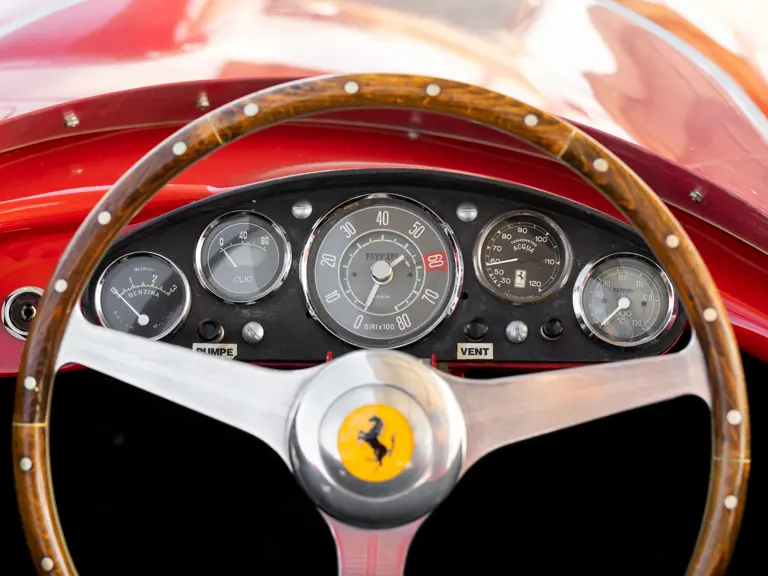

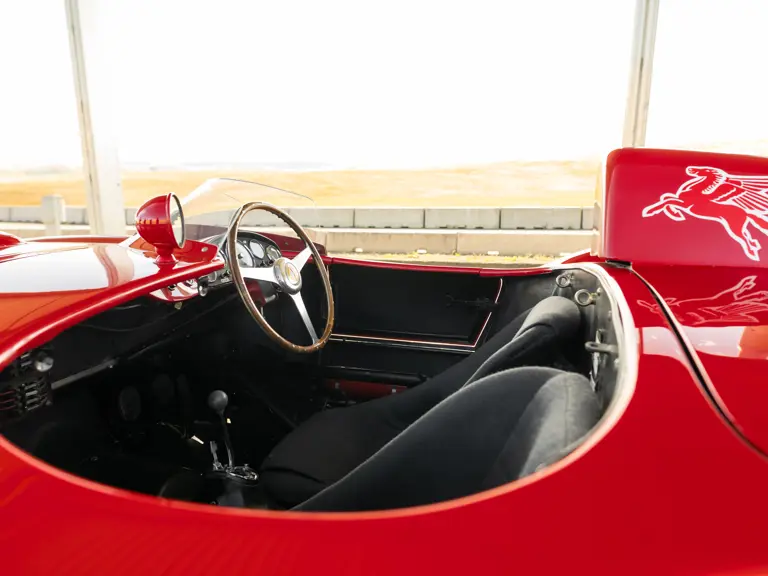
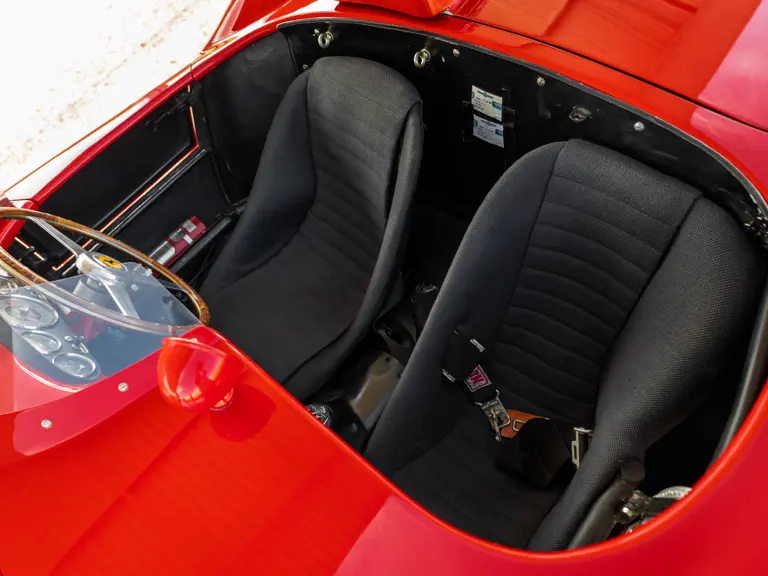
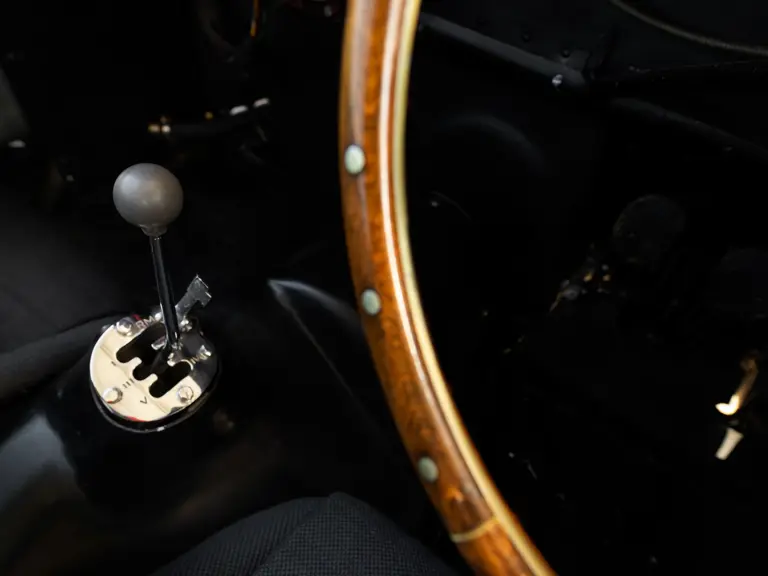
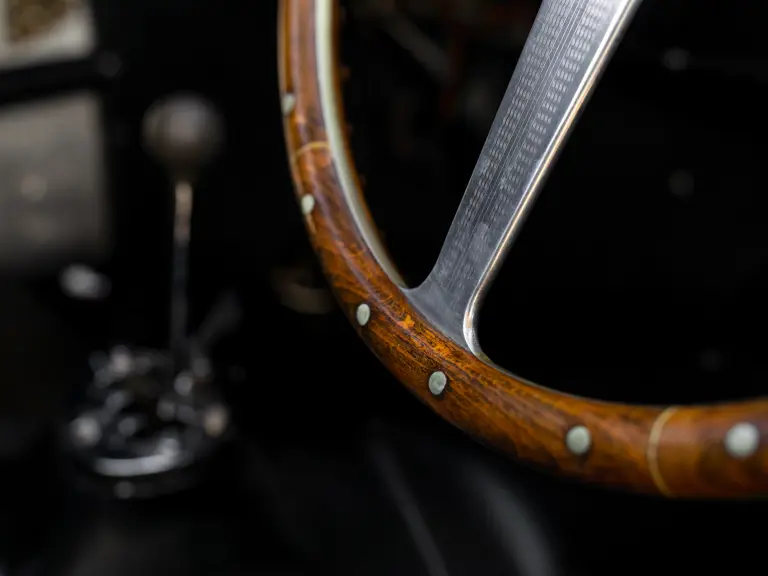
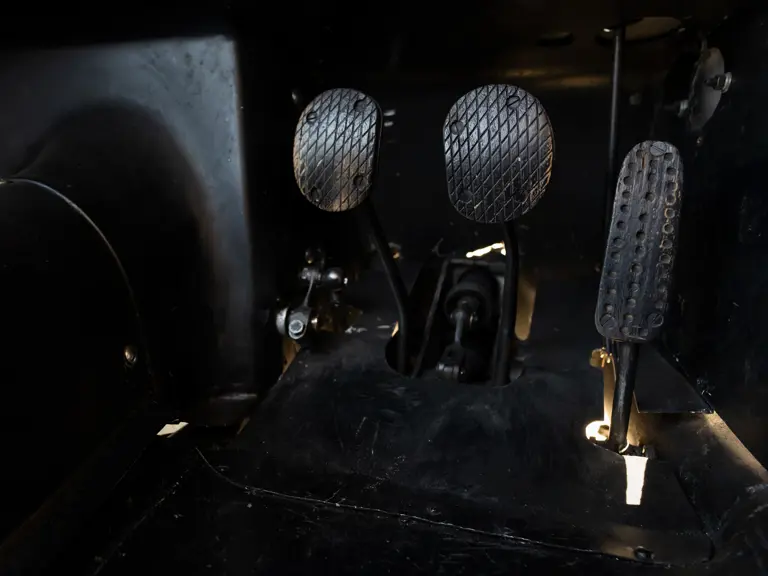
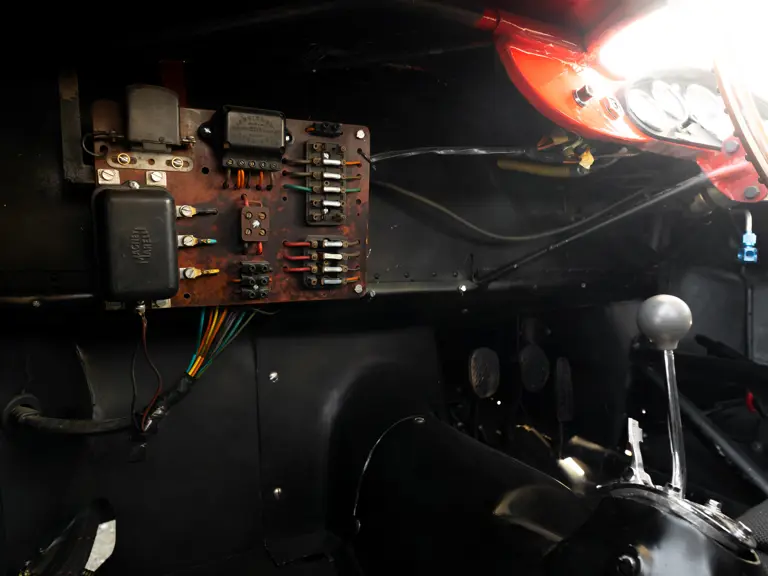

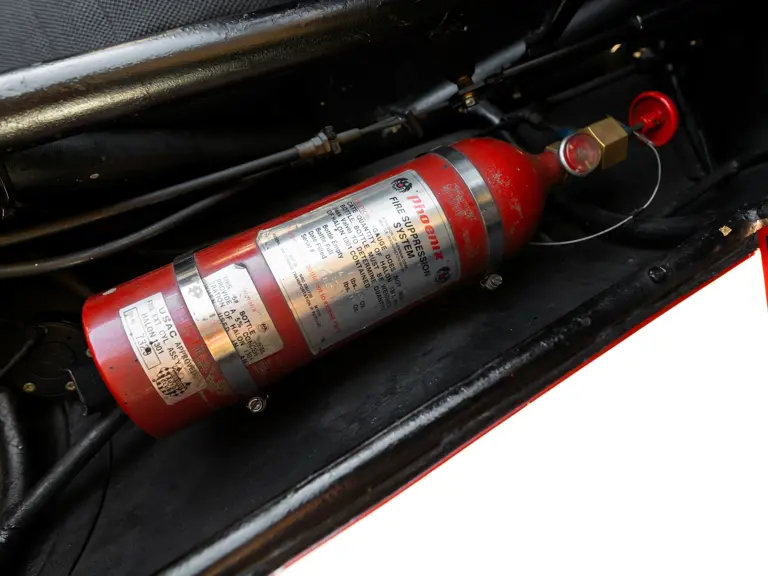
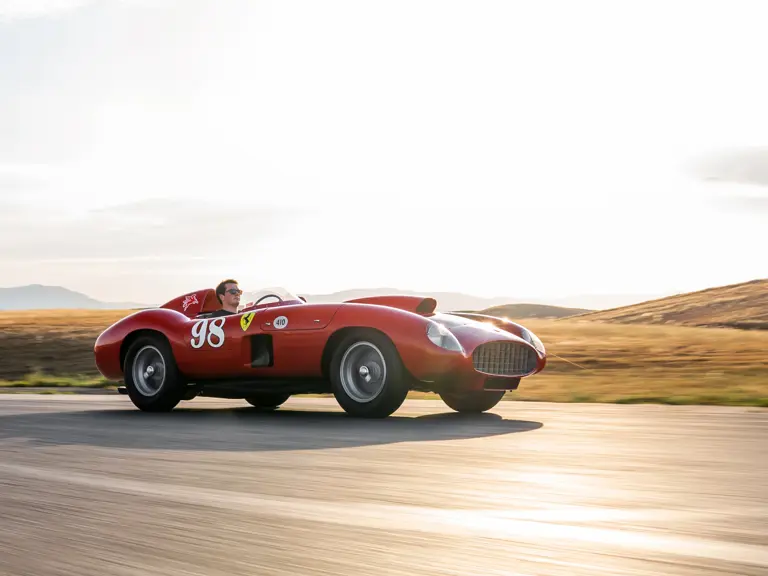
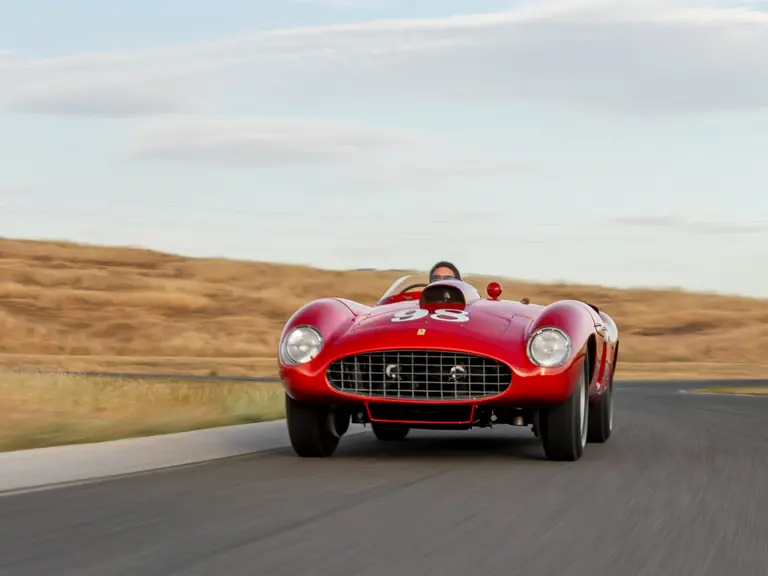
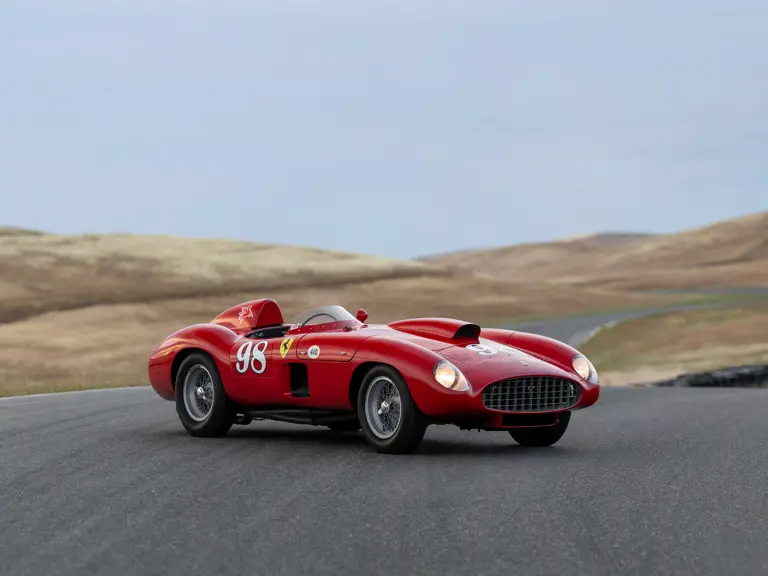

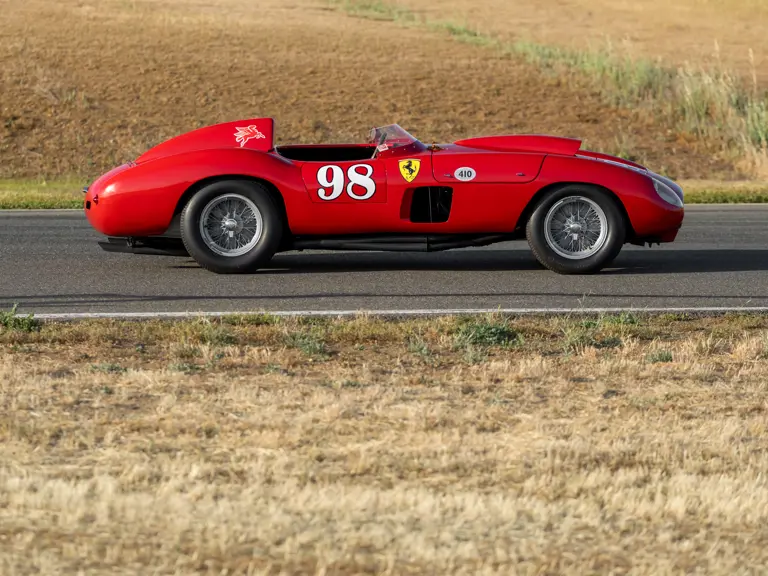
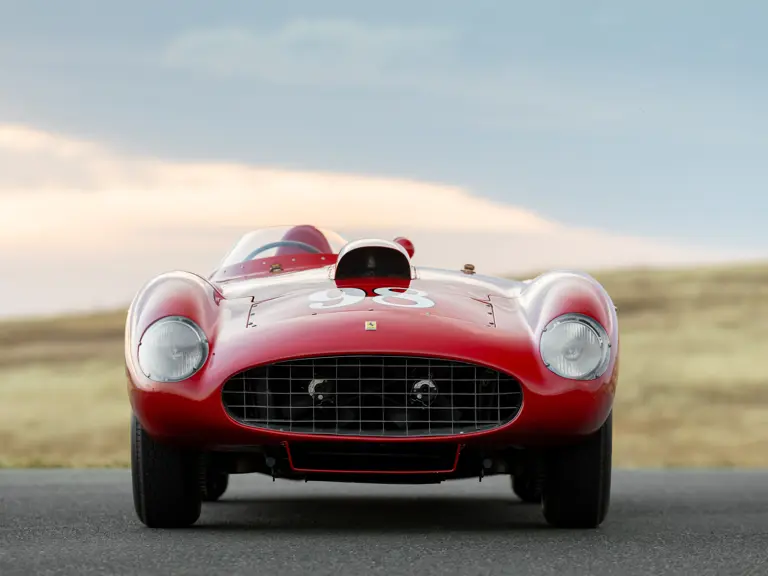
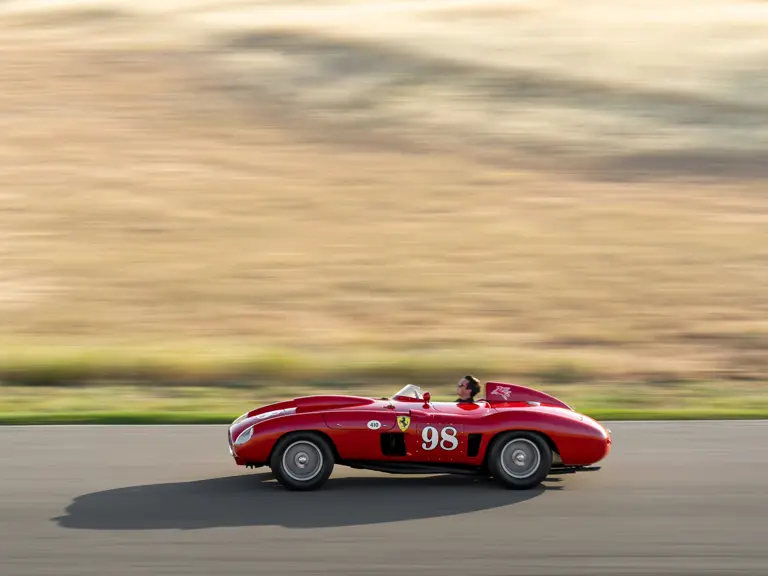

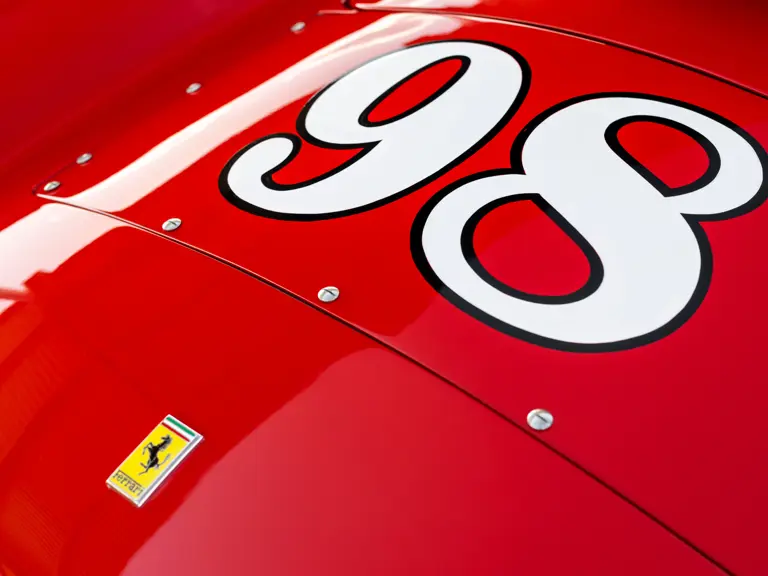
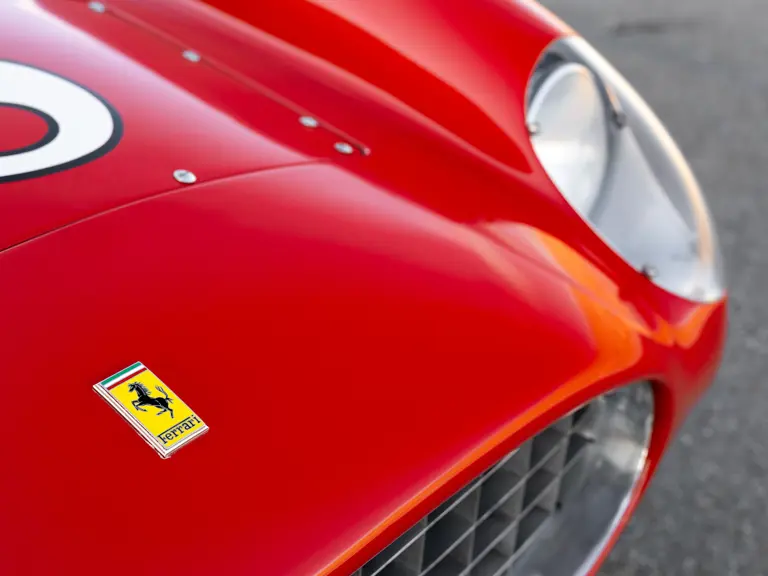
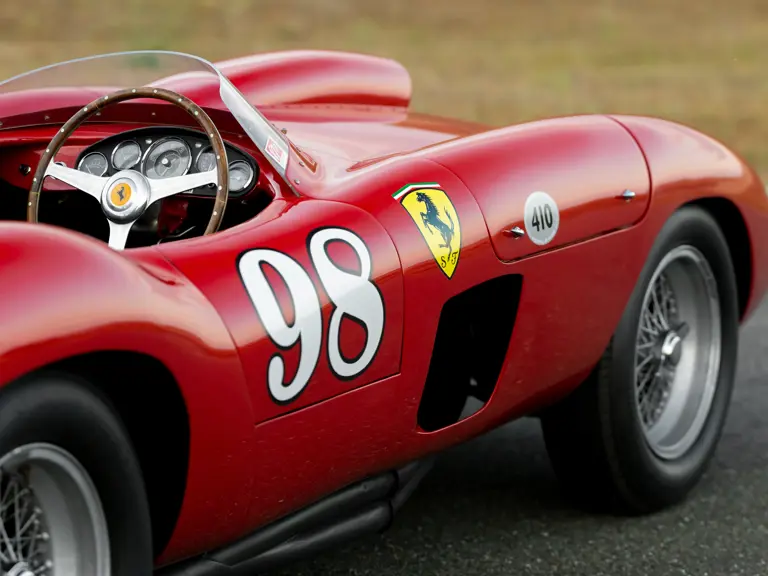

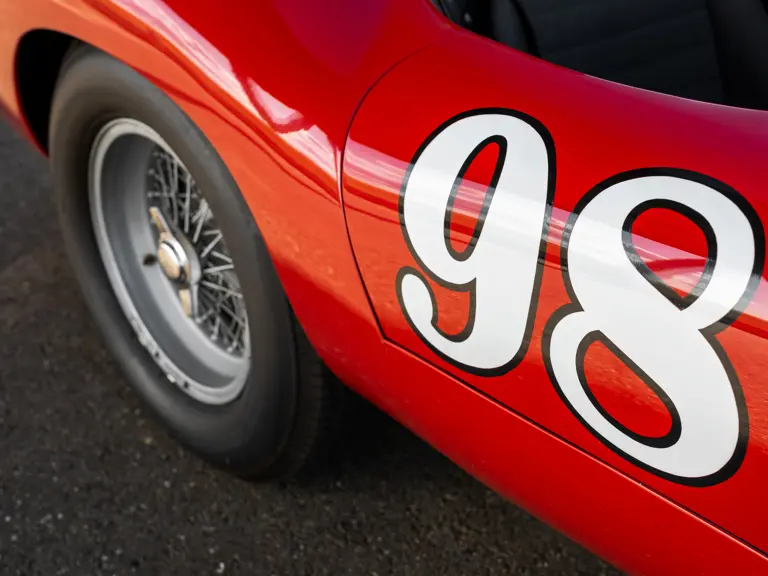

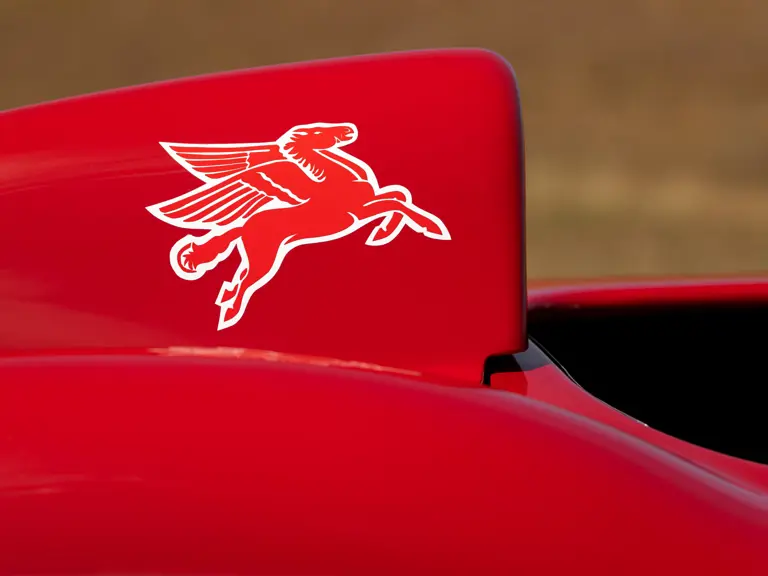


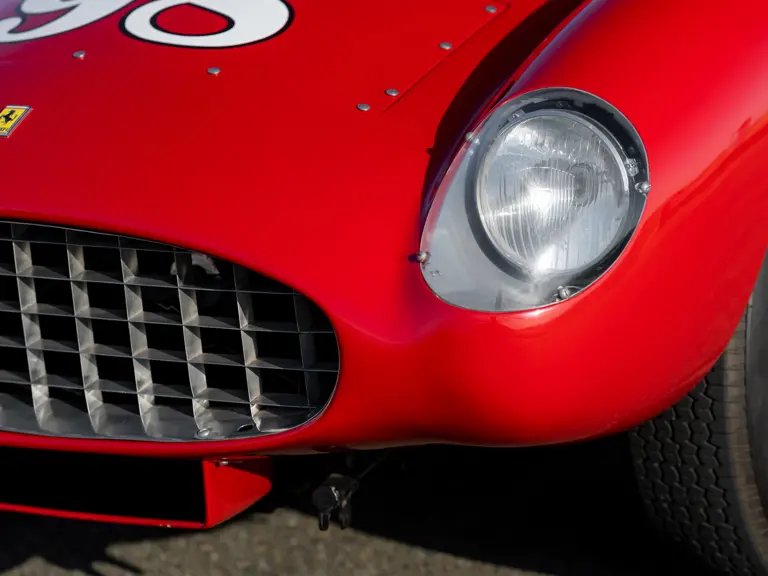

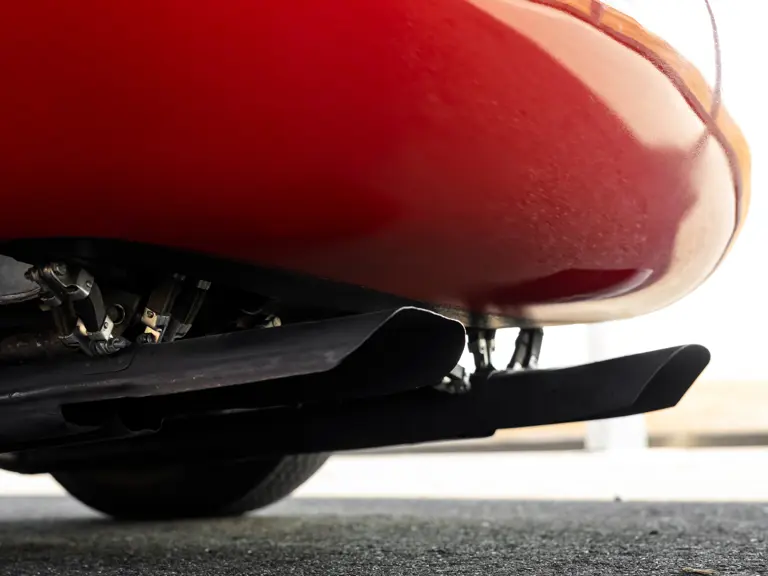
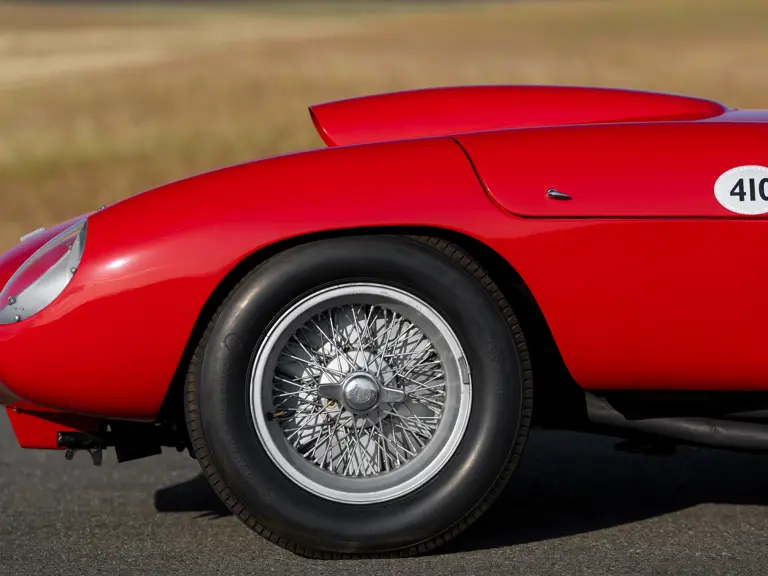
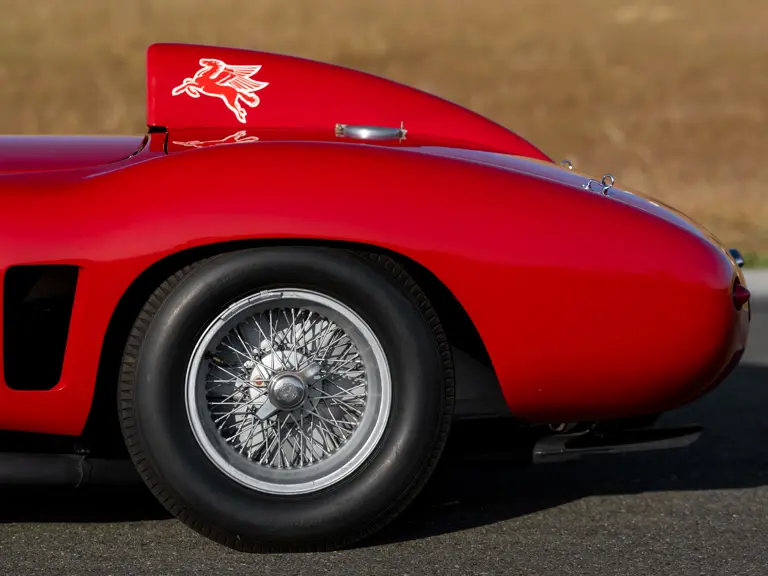
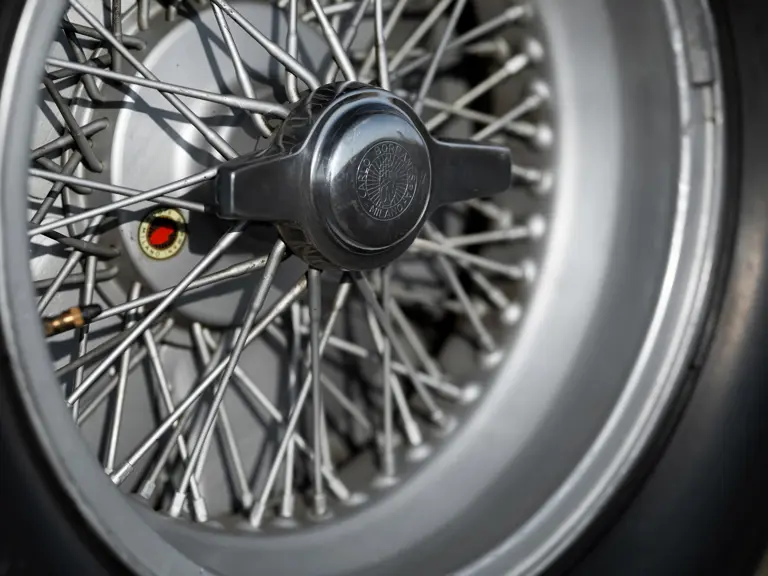

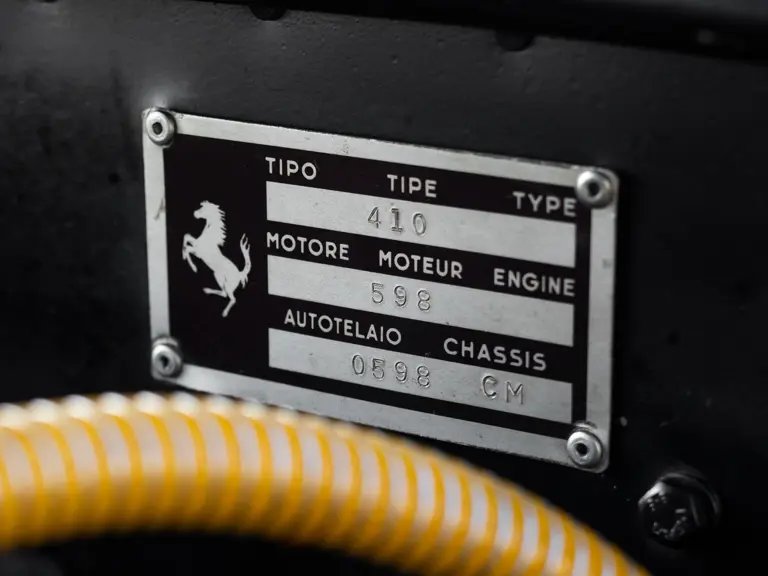
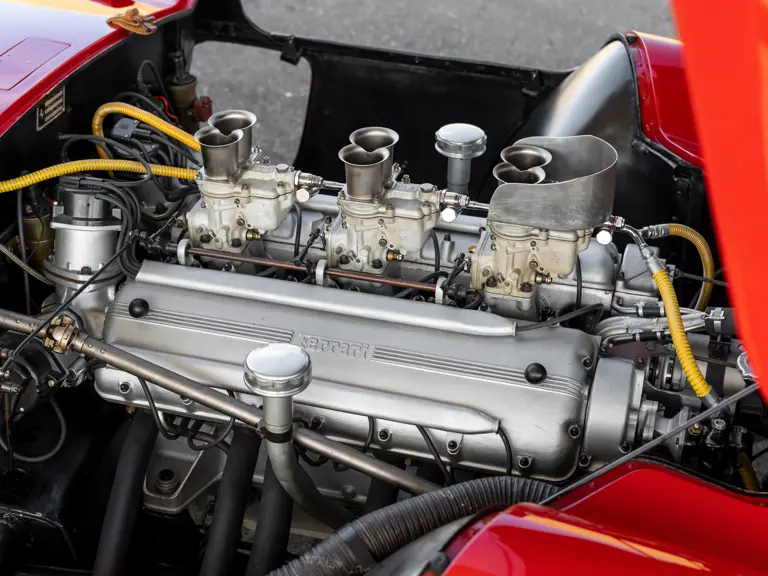
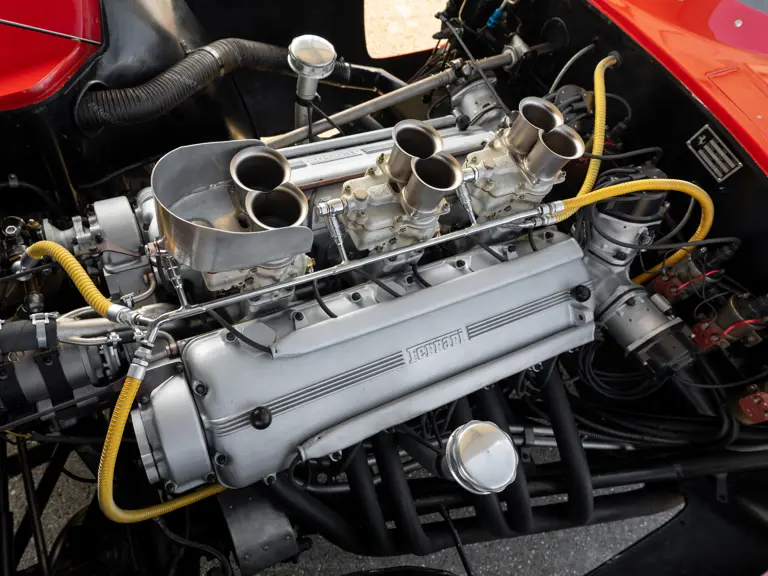
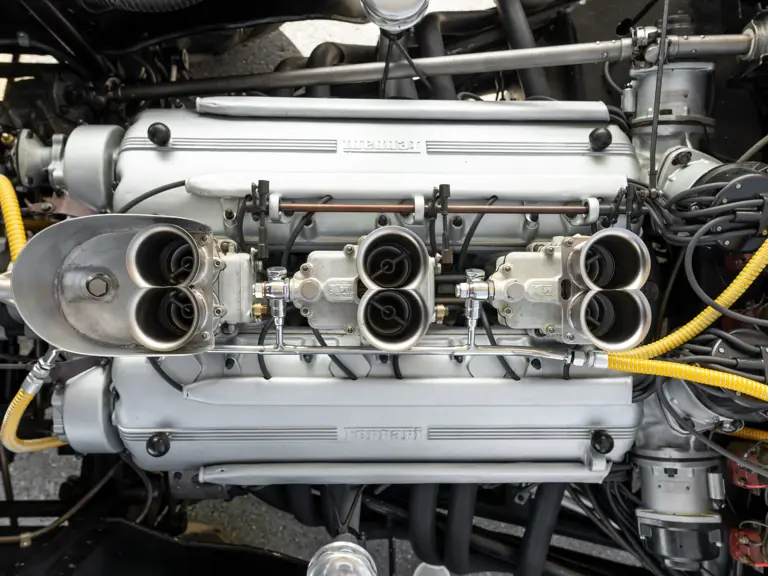
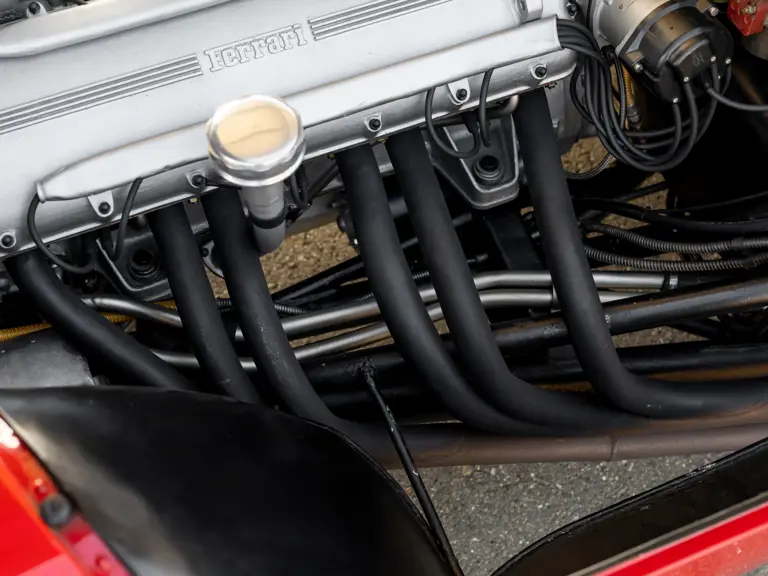
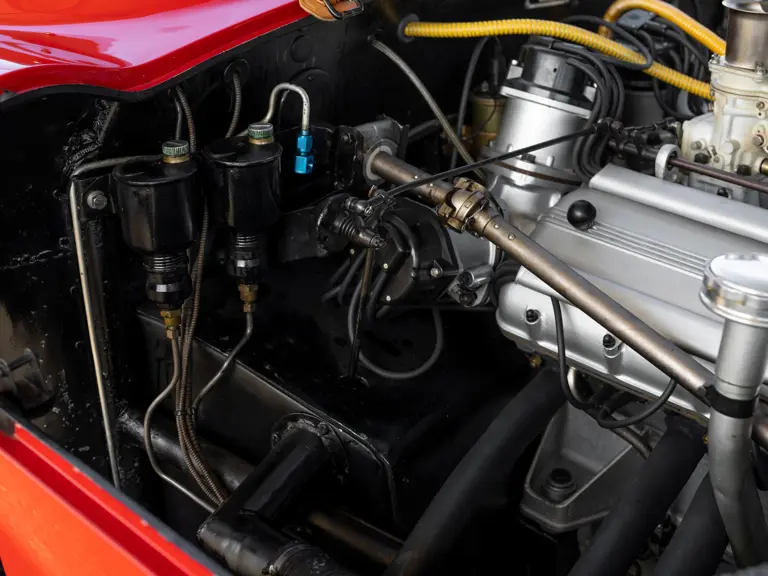
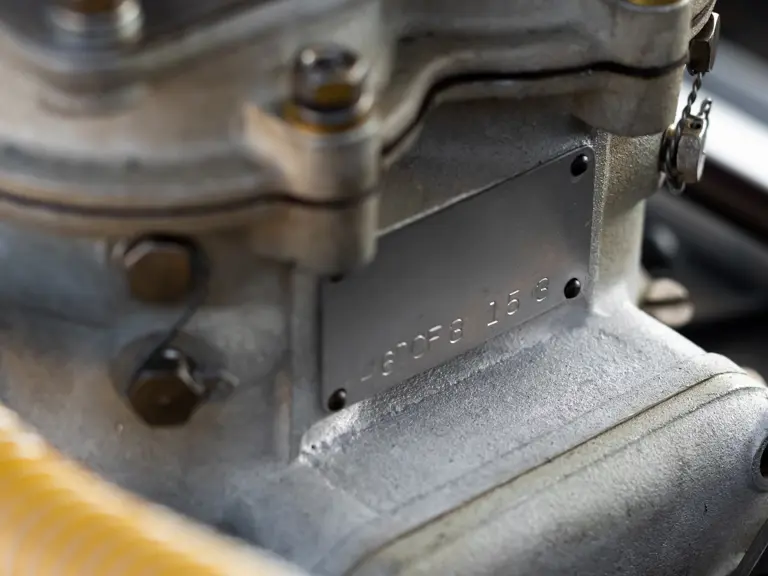
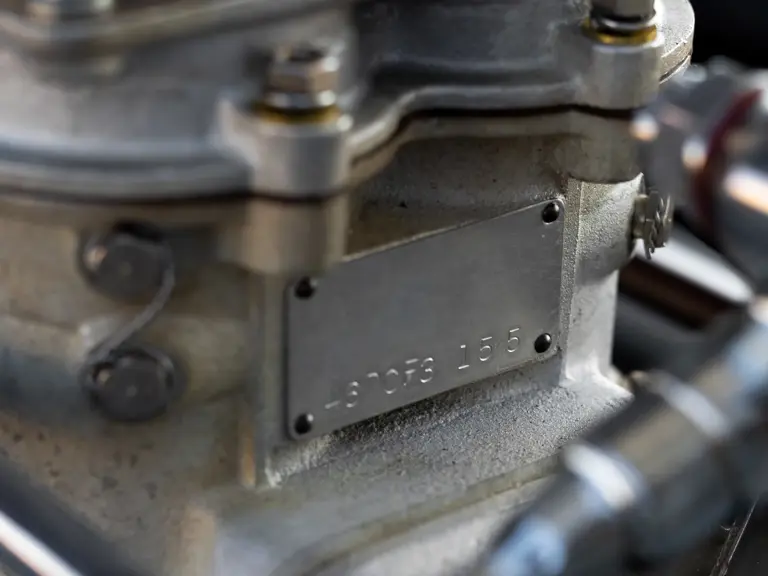
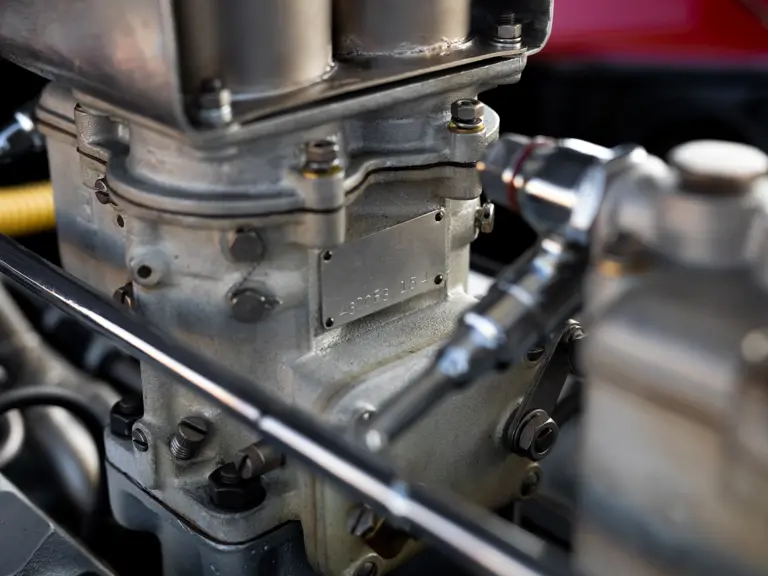
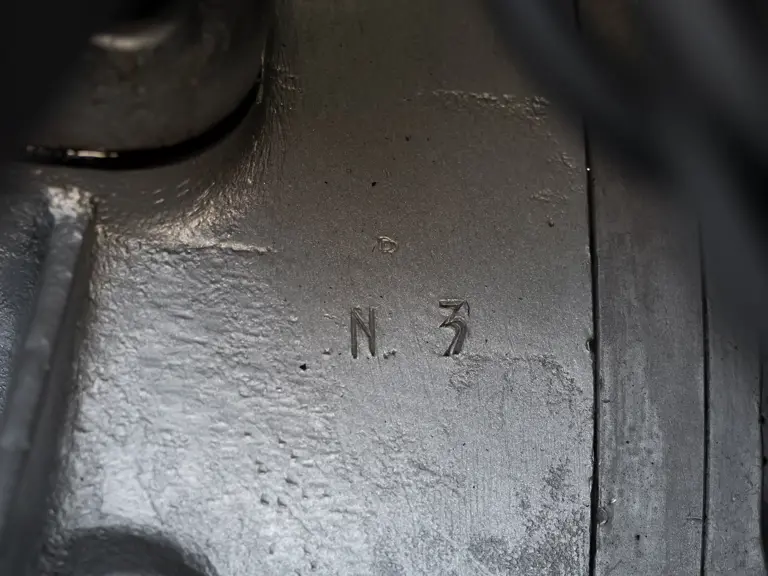
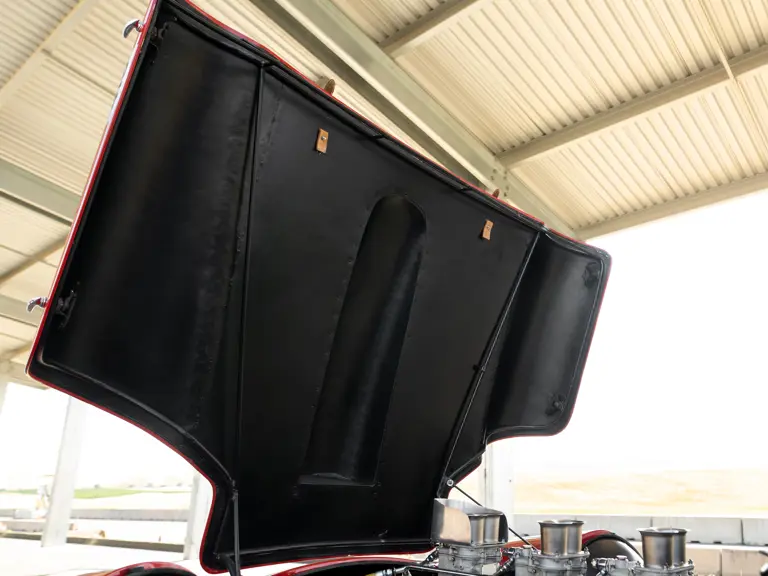
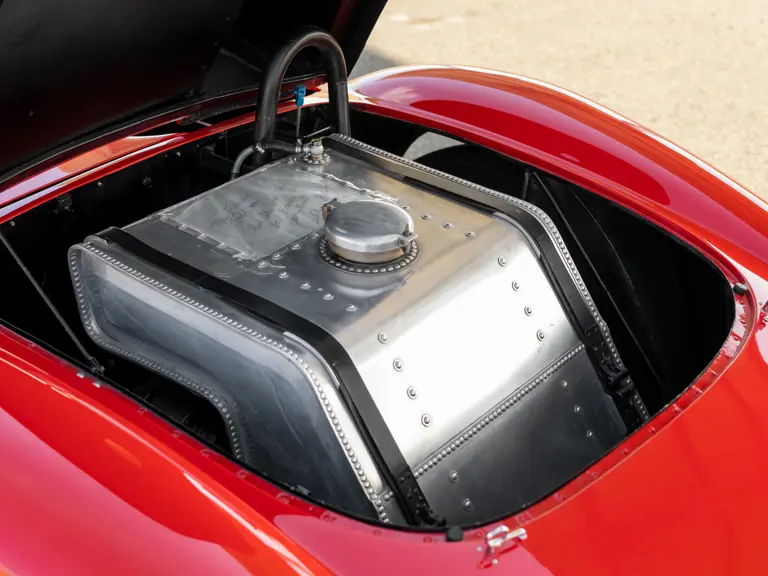
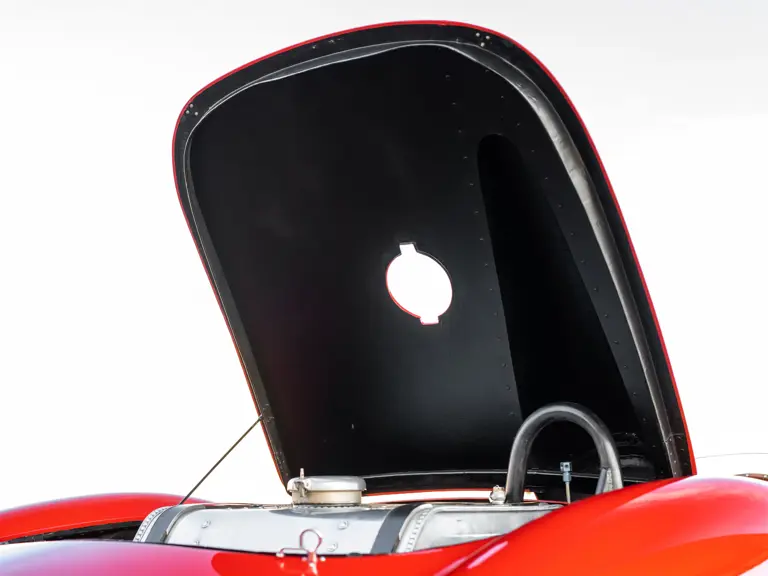
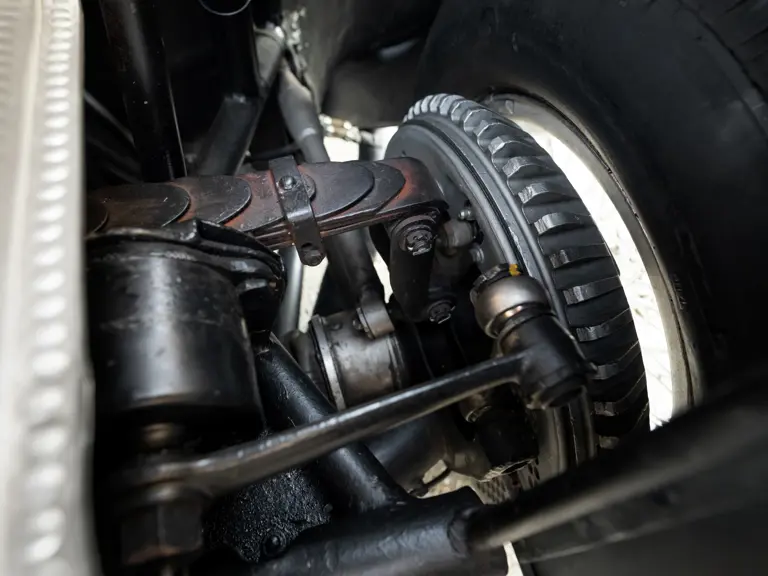
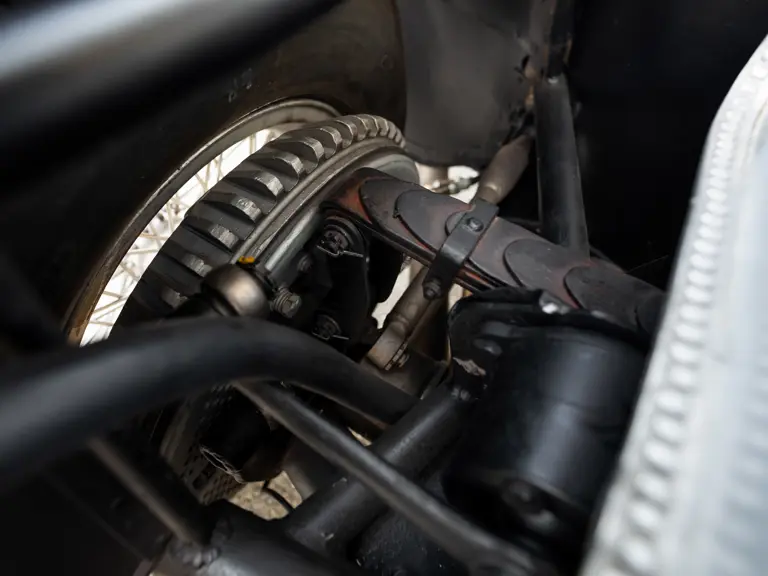
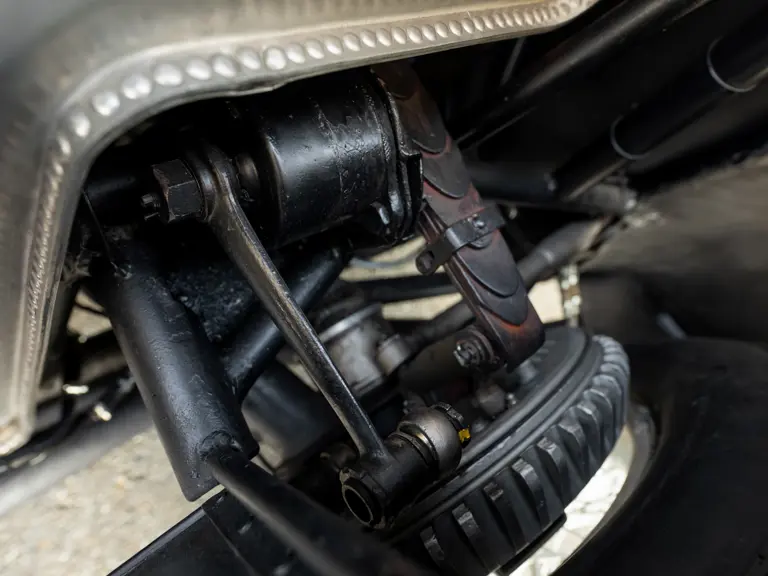
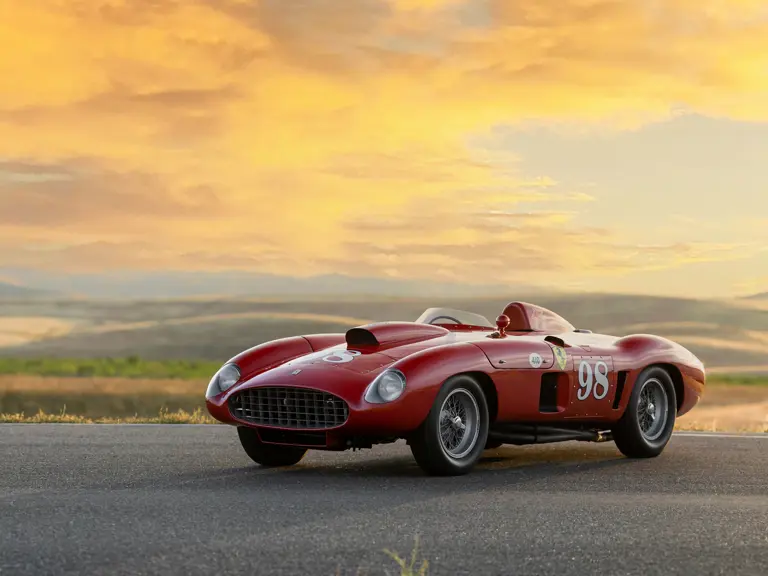
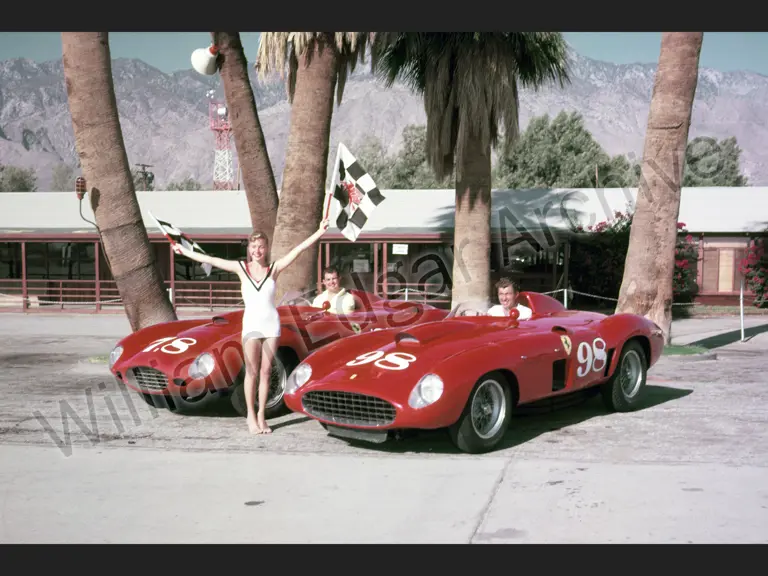

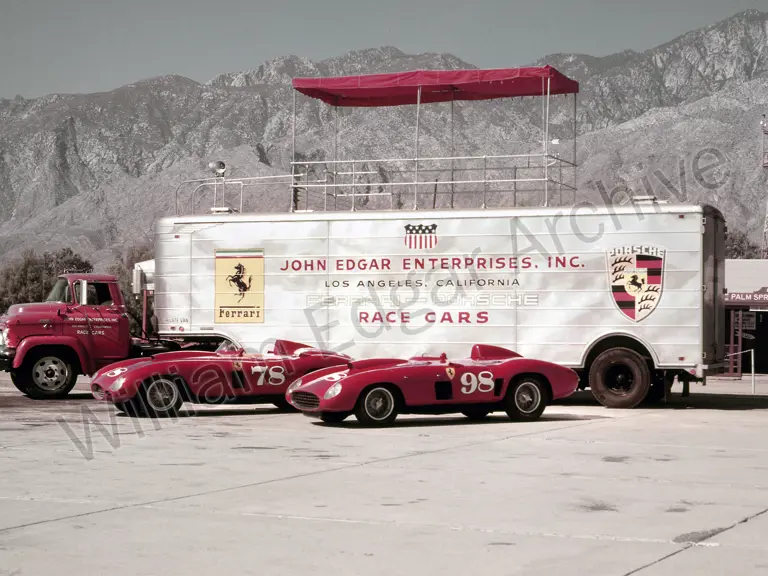
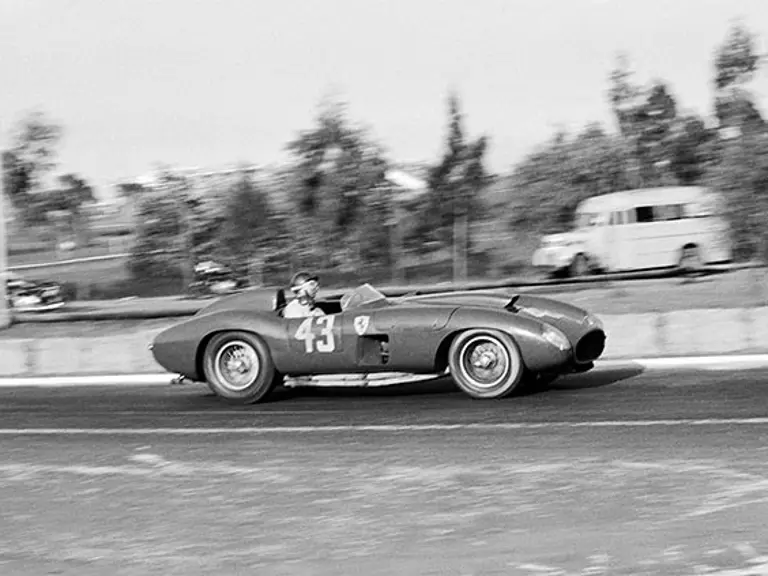

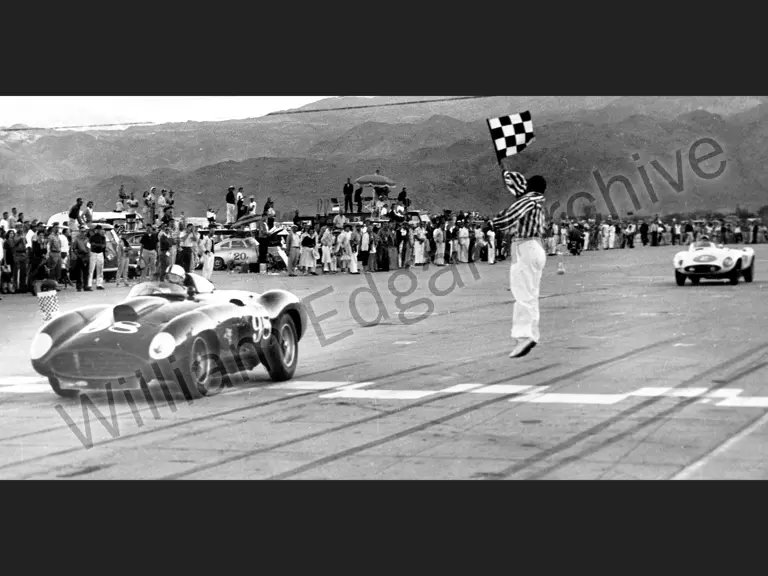
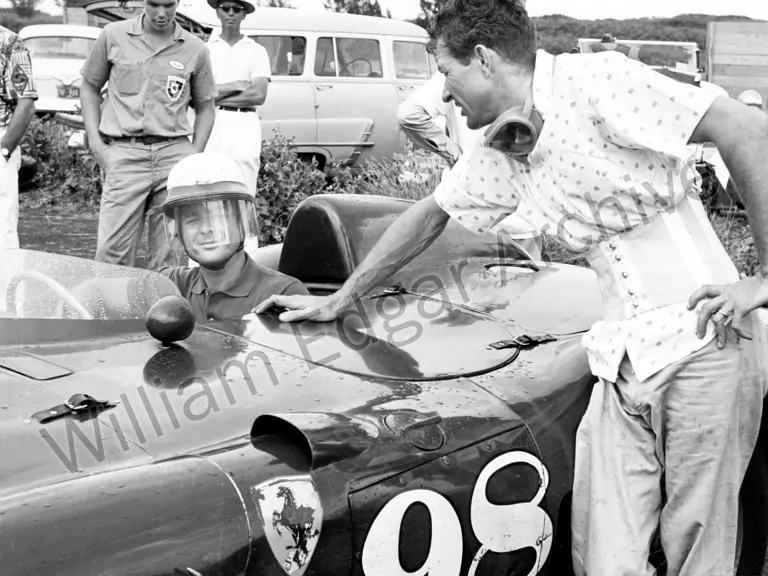
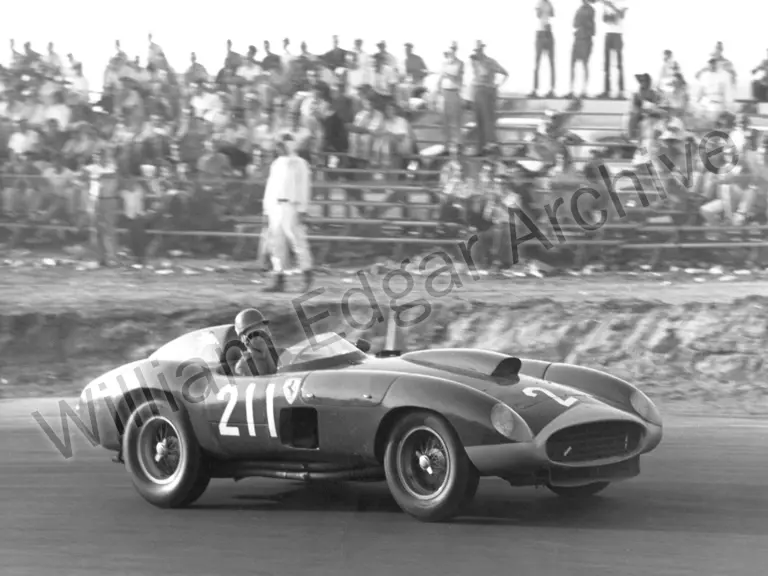
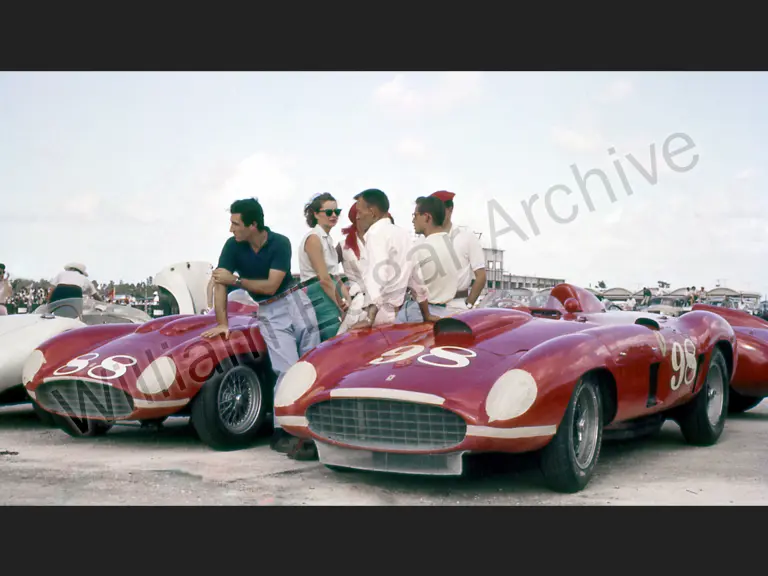
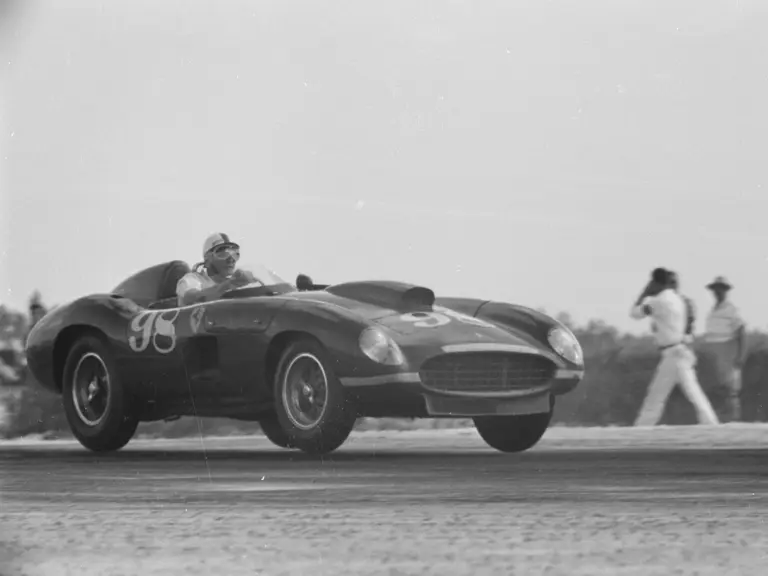

 | Monterey, California
| Monterey, California
